#and was one of the main people of the art deco periods
Explore tagged Tumblr posts
Photo

That’s actually probably largely dead on the money, and I love your interpretation of the family dynamics, valid.

The Consolation by JC Leyendecker, oil on canvas.
#couldn't get any specific information on this painting#but from googling#was a prominent commercial illustrator#worked during the art nouveau and art deco periods#and was one of the main people of the art deco periods#he did a lot of illustrative work for the Saturday Evening Post#think Norman Rockwell#generally he'd do covers ads or posters that largely featured scenes like this#self evident works illustrating relatable moments in the average american life#with quotations around relatable and average#because even that is a subjective and power laden choice#sorry shifting into art history and anthropology mode#but otherwise most of his work is what it says on the tin#although the meaning of art as always is built in the relationship between the viewer and the work#art history#jc leyendecker
2K notes
·
View notes
Text



Started out with the most complex designs for the iasuw au because I realize that if I ever draw them on another time, I can determine when I would regret making these in the first place.
Some info below about the designs!
Gideon's was made with the main theme of steampunk. With him being a mechanical engineer (technically one in actual canon, but in this au he has a degree in it), he would likely have an affinity to gears and mechanisms.
The front design is based on steam train engines, while the back is more liberal with wings to represent a phoenix
The middle of the back design also has a bear surrounded with wheat to represent his home of Yona (the bear being its relative animal based on the wiki). It would also have a quote, something like "The blessed of Yona are born with fortune" (pending don't take me on this ssdjkaldjasd).
I had quite fun with Torbek's actually since you can take his design anywhere. Although I mainly stuck with the style of gothic/art deco because I was inspired with the storyline of his past in canon (as well as his basis on mr. jekyll and hyde which ofc was written in the victorian period with gothic aesthetics. the art deco was more aesthetically close with what I was imaging).
And since we are talking about pasts, his front and back designs involve people that he is supposed to know which is a "Clementine" and "The Othe".
However, coincidentally for this a.u, he does not remember that much about them aside from their names and that he got the tattoos during a stint in prison (his memories are also blurry about it - very Harry of disco elysium coded).
#legends of avantris#once upon a witchlight#ouaw#It's always sunny upon a witchlight au#IASUW au#tattoo/flower shop au#gideon coal#torbek#apolaskiart#finally got this one out as well of the art idea list
107 notes
·
View notes
Note
So what time period does vodka take place in. And who do have in mind for the main cast as of now?
Time period wise, It's somewhat contemporary with aesthetics similar to art deco (like Skullgirls or Batman TOS) and some high tech used by rich to secure their wealth and for the military police.
As for the cast I'm still developing the stories and characters but here's what I have so far:

Vodka (Hooch) - Opossum thief raised by gangsters. He and his friend, an eel named Soda, wanted to rise to the top of the criminal underworld. But his friend betrayed him and had him whacked. He survived and was nursed back to health by a retired legendary thief who taught him her skills and he now uses her teachings to take down the criminal underworld and the corrupt elites who collaborate with them.

Whiskey - Young prodigious orphan street cat who is an inventor. His parents were mechanics and died when their shop was burned down for not paying their mafia protection racket. Now he tries to hunt down the people responsible and use his tech knowledge to build special gear to investigate, trick, and fight them. He teams up with Vodka as their causes (going after organized crime) aligns.

Brandy - Journalist trying to uncover corruption, organized crime, and the identy of Vodka the Thief. In her youth, she was a childhood friend of Vodka who tried to keep him out of trouble. However, she broke away as he began a life of crime. Her father was framed by the company he worked for and made the fall guy for their crimes and sentenced to prison. To prove her father's innocence, she became an investigative reporter to uncover corruption and expose the truth to the public. She tries to find out the identity of Vodka's thief alter ego as uncovering the popular thief would help her career. She befriends Vodka who unbeknownst to her is the thief and slowly becomes more sympathetic to his cause as she sees the impact the thief's charity has on the city.

Cognac - Shapeshifting cuttlefish actor who uses his transformation ability to disguise himself to aid in heists. He dreams of being a famous actor and uses disguises in heists to refine his acting skills. Sometimes he gets too invested in his role and loses himself in the character, sometimes in ways that stirs up the heist!

Rum - Retired Legendary Theif who led a troupe known as the Merry Marauders who stole from the wealthy and gave to the poor. The group has dwindled from arrests and death over the years and disbanded. After saving Vodka, he inspires her to rebuild the Merry Marauders and train him. She acts as the group's Splinter if that makes sense.

Sangria - Former ally of Rum who defected because she believed Rum didn't go far enough to fight against the corrupt wealthy and criminal organizations. She works as an assassin who takes jobs to kill those who abuse their power. She gets into conflicts with Vodka's group as her trying to kill the person their robbing throws their heists into chaos but sometimes they end up forming alliances of convenience.

Soda - Vodka's ex-friend who betrayed him to rise the rranks of his criminal organization so that he can amass power and status for himself. He gets tasked by the mafia to advance their illegal aims and Vodka and friends often end up in conflict with him. He never wanted to betray Vodka as he sees him as a brother but he's beholden to their orders of his manfia leadership, which is why he wants to take over the crime organization and rule the city with his own vision. So that he's free and not beholden to the orders of anyone.
There's more characters, but that's the gist of a few important ones. Defintely going to develop the idea further. Love to hear any feedback from y'all ^u^
19 notes
·
View notes
Text
Dev diary - What is the history period that inspired the world of 'Heroes Of Oblivion'?

(Some light spoilers for my game 'Heroes Of Oblivion' below .)
This time period is the 40s or, rather, sci-fi 40s, with computers and technologies straight up from modernity or science novels. The atmosphere is both utopian and dystopian, nostalgic and futuristic, creating the feeling of both sugary happiness and resort-like calm (in Tristia's case) and technological advancement (Tibor).
As stated before, Tibor was also inspired by art deco, movement and constructivism, an even earlier art movement. In the 40s those two old styles weren't the matter of dreams anymore, they were put into practice by many countries such as USSR, Germany and USA.
Those are the main three sources of inspiration behind Tibor's visual style and its technologies.
Below, you can see some utopian images that remind me of Tibor. (And some of Tibor's style is already 50s, because their people are richer so they can afford being very fashionable)





(The retrofuturistic gun above is kind of similar to Blackthorn's one.)
But this toy (below) is even more similar.


(Note how Blackthorn's clothes are as mundane compared to his gun as those of the men in the first image. Retrofuturism can work in funny ways like that)
As for Tristia, its 40s roots are more obvious. It is stuck in the past, after all, and in the kind of past that is 'mythological" so it's kind of "double vintage".
Here, comparisons are with either countries who hold onto their legendary past despite the challenges they face (United Kingdom, France...) or simply those which don't have enough resources to be advanced (Poland, Czechoslovakia).
Unfortunately, there aren't many illustrations to show what exactly I have in mind because most people in Tristia were poorer than that but since our characters are rich, I guess, these images of careless resort living fit them well.


(This suit above is fairly Blackthorn-coded, for example)
And here is Credence's sweater vest.


From 'the other side of the tracks' comes Mort's terrible (cheap) hawaiian shirt:


Overall,the atmosphere of Tristia is pleasant, and a bit nostalgic. Like a chilrden's picture book indeed.






Thank you for your attention!
3 notes
·
View notes
Text
Ecarden: Machinery of the Heavens
Ecarden is a very advanced and high-tech world, populated by a single biological sentient species self-named the engrath. Technically, there is also a bunch of sentient AI which was made in spite of the ban, but we will talk about those later. Despite a clear sci-fi focus, Ecarden has an unexpectedly vintage and even art deco look, with a great balance of urbanization and the preservation of nature as it is.
The entire Ecarden is divided into 22 autonomous cities called Districts, which in action are full-fledged states, forming together a strong alliance ruled by Ecardian Council. The common language, which was created at the beginning of the Era of Watchmaker, left all of the older languages in the past. However, each District possesses its own culture, laws, and general appearance. Power (except for the judiciary) belongs to the parliament and the Governor (aka the head of state), each elected for a five-year term.
And, perhaps the most important thing…
Ecarden is a world, where there is a rightful God!
*** Main characters
The main events take place in the 4th District in the backdrop of a few sudden serious problems, hence the main characters: the God themself, the Clergyman of the 4th District, his assistant AI in a body of an android, as well as the Governor of the 4th District.

As a deity, Watchmaker can shapeshift to any form, however, they rarely use this ability, dwelling on the images familiar and tested by time.
Watchmaker is the creator of the universe, but not the origin of the life existing in it (appearance of which, by the way, had become a real surprise for them). Being a demiurge, they are not a "God" in the sense in which we are accustomed to using this word, and for this reason, they call themself Watchmaker by analogy to the profession of a master-creator of the time mechanisms. In Ecarden Watchmaker acts like a full-fledged patron of arts and sciences, who with their own free will is ready to help with the development of the world and provide assistance with technology. They're considered the "Blind God", which means that they aren't a deity reigning over the world and watching over everything and everyone, but rather simple architect who knows about what is happening from the interactions with the Clergymen, who are mediators and representatives of each District, the most outstanding engineers who create the most advanced technology under Watchmaker's guidance. As a patron, Watchmaker presents the most important discoveries and innovations to the public, participates in ceremonies (such as Governor's inauguration, for example), and leads the main holiday of Ecarden named Thanksgiving Day, giving parting words and wishes for the next year, while maintaining a festive atmosphere.
***

Even though Eve and the other employees of the Complex have their uniforms, mostly it isn't forbidden to wear casual clothes, which he does quite often.
Zhaneeve Hezenlight is a Clergyman of the 4th District, a talented engineer in several fields, and a little bit practicing bionic. Most call Zhaneeve simply Eve, including employees of the Complex themselves (not to mention his close social circle).
His duties, like any other Clergyman, include:
Application in the development technologies which already exist and solving current problems with their help;
Development of completely new technologies (optional);
Periodic reports to the Watchmaker about what is happening in the headed District.
In addition, as one of the most competent bionics, he is also responsible for carrying out the most serious and urgent prosthetic operations and, in fact, mechanization in these cases.
On paper, each Clergyman is the head of the Complex of their District, the research center in which most of all development is carried out. In reality, Clergymen are very busy people, and each Complex is led by its deputy, leaving only the most important issues to the Clergyman.
Positive and kindhearted, always young in his soul (and a bit like a fashionista) Eve does plastic surgeries twice as frequently as any other engrath, he’s nonetheless quite a responsible person and tries to lead Complex and all the work going on there in the best way possible.
***

Helper uses his small size and funny robotic look as an advantage. To display his emotions, he uses emoji or emoticons, sometimes reaching a completely absurd look.
Helper is an AI in а body of an android. He was created by Zhaneeve and originally was planned as a simple robot for small assignments, but Eve's creative approach (and his reluctance to do everything "according to a template") led to an unexpected result — AI gained consciousness and an edgy personality.
Possessing highly doubtful morals and being an obvious nihilist, the outwardly sarcastic and unfriendly assistant is the complete opposite of his creator. Barely recognizing any kind of authority, he doesn't perceive Eve as his creator, and even less as his boss, and works with him in a cooperative on a basis more similar to that of a friend, which doesn’t bother either of them as of yet.
Basically, Helper is something in between an omnipotent intelligence and a 7-year-old child (his real age), has his own Vlog, likes rap, and is quite good at it.
***

Dark clothes are quite rare for a visually light Eсarden, and yet Nahash approves only two colours in his clothes which are black and burgundy.
Nahash Сerdes is a Governor of the 4th District. In general, he’s a rather serious and domineering man, one might even say harsh but he does an excellent job, for which he is very much loved by the townspeople. As the head of an almost full-fledged state, he bears a huge share of responsibility, and in practice also the entire executive power, which, however, doesn't bother him that much. He had changed his name and hides any true information about his past, had some traumatic experiences throughout his life that caused PTSD nightmares which make Nahash suffer from insomnia.
Officially, Eve is Nahash's personal bionic, who solves all issues regarding his mechanization, but in reality, these two are connected by a love affair something… more.
***
Character's voice canons
Saint Motel — Eat Your Heart Out
This song perfectly reflects cheerfulness, love for playing the guitar, and, to some extent, even Eve's philosophy.
Slide — See Thru Blue
Nahash's voice is usually a little bit more bassy, but he almost always talks to Eve in exactly this way.
Son Lux, Mitski, David Byrne - This Is A Life (male)
Watchmaker has an exceptionally polite manner of communication, as well as calm, measured speech. However, their voice changes slightly from time to time, similar to their appearance.
***
And finally…

Small typing of characters according to the lyric heroes from the song The Oh Hellos - Soldier, Poet, King, which isn't a canonical display of their professions, remains very indicative for understanding what all three of them are.
#concept art#my art#comic#comics#webcomic#lgbtq comic#lgbtq#enby#nonbinary#queer#gay#art#digital art#artists on tumblr#art page#oc#original character#furry#anthro#original species#article#machineryoftheheavens#MOTH
4 notes
·
View notes
Text
Vintage-Style vs Modern Designed Pendants: Which is Better?

When choosing the perfect pendant, deciding between vintage style and modern designs can be tough. Both styles offer unique beauty. Each one speaks to different tastes, aesthetics, and values. Whether you're drawn to the intricate details of vintage pieces or the sleek lines of modern designs, understanding the key differences can help you make an informed decision. This blog will explore vintage-style and modern pendants, comparing their characteristics, advantages, and what makes each attractive.
What Defines a Vintage-Style Pendant?
Vintage-style pendants are inspired by the designs of past eras, often reflecting the jewelry trends from periods like Victorian, Art Deco, and Edwardian times. These pendants typically feature intricate details, ornate patterns, and craftsmanship that recalls the grace and romance of ancient times.
Key Features of Vintage-Style Pendants:
Ornate Detailing:
Vintage pendants are known for their elaborate designs. Filigree work, engraving, and milgrain edging are common elements that give these pieces a handcrafted and artistic look.
Romantic Aesthetics:
These pendants often evoke a sense of nostalgia and romance. Vintage pendants, with motifs such as flowers, hearts, and nature, can feel emotionally rich and meaningful.
Antique Stones and Metals:
Vintage-inspired pieces often use sapphires, emeralds, or rubies, which were popular in past eras. Rose gold or oxidized silver also adds to the antique feel.
Timeless Appeal:
Vintage-style pendants have a lasting refinement that surpasses trends. These pieces are suitable for women who appreciate classic, timeless beauty.
Who Should Choose a Vintage-Style Pendant?
Vintage pendants are ideal for those who love old-world charm and sentimental value in their jewelry. If you enjoy art, history, or wearing something connected to the past, this style might echo with you. Vintage pendants also tend to be more intricate and elaborate, making them perfect for someone who loves attention to detail and unique craftsmanship.
What Defines a Modern Pendant?
On the other hand, modern pendants embrace contemporary aesthetics. They are characterized by minimalism, clean lines, and sleek designs. These pieces appeal to today's trends, focusing on simplicity and innovation.
Key Features of Modern Pendants:
Check out the main features of contemporary pendant designs.
Minimalistic Designs:
Modern pendants often favor simplicity. Clean lines, geometric shapes, and smooth surfaces define this style, offering a fresh and contemporary look.
Innovative Materials:
Modern designs incorporate titanium, stainless steel, ceramic, and traditional metals like gold and silver. Using unconventional materials adds an edgy, bold flair to contemporary pieces.
Abstract and Geometric Shapes:
Unlike vintage pendants, modern styles often use abstract or geometric shapes. These designs are ideal for people who prefer a less traditional and more artistic look.
Customization Options:
Modern pendant pieces frequently offer a range of personalization options. You can opt for engraving or interchangeable elements, allowing you to express individuality.
Who Should Choose a Modern Pendant?
A modern pendant is ideal for individuals who appreciate contemporary design and value simplicity. It enables users to keep up with current fashion trends.
A modern is perfect if you love wearing something sleek, innovative, and versatile. Modern pendants can also complement a minimalist wardrobe, making them a great everyday accessory.
Comparing Vintage and Modern Pendants: Which is Better?
Design Complexity vs. Simplicity
Vintage-style pendants are more elaborate and ornate, highlighting craftsmanship and intricate patterns. In contrast, modern pendants are often more simplistic, focusing on clean lines and minimalist aesthetics.
The better choice depends on personal style. A vintage-style pendant will stand out if you prefer jewelry with historical flair and delicate details. On the other hand, if sleek, modern fashion is more appealing to you, a contemporary design will suit your taste.
2. Sentimentality vs. Trendiness
Vintage pendants often carry a sense of sentimentality and romanticism. Whether you're attracted to the craftsmanship of a particular era or the nostalgic designs, they evoke a strong emotional connection.
Modern pendants, on the other hand, are more aligned with current trends and innovation. If staying ahead in fashion matters to you, then modern pieces will likely appeal more, whereas vintage designs resonate better with those who appreciate jewelry with historical significance.
3. Versatility
Due to their minimalist designs, modern pendants tend to be more versatile. They can be worn daily and paired easily with various outfits. Their simplicity makes them adaptable to both casual and formal settings.
In contrast, due to their elaborate designs, vintage pendants are often seen as more formal or occasion-specific. While they are stunning statement pieces, they may not blend seamlessly with everyday fashion.
4. Durability
Modern pendants often incorporate more durable materials such as stainless steel, titanium, or ceramic, making them suitable for regular wear.
Vintage-style ornaments, those with intricate filigree work or delicate stones, require more care to maintain their beauty over time. A modern pendant could be a better option if you prioritize long-lasting, low-maintenance jewelry.
Which is Better?
The answer ultimately depends on your personal preferences and lifestyle. A vintage-style pendant may be the perfect choice if you are drawn to sentimentality, history, and intricate design. On the other hand, if you prefer minimalist designs, sleek shapes, and versatility, a modern pendant may better suit your taste. Both styles offer their own unique beauty, so the "better" choice is the one that aligns with your style, how you plan to wear the pendant, and what resonates with you emotionally. For every occasion, shop for elegant pendants from DNCR ENTERPRISES, INC., and reflect your style. Give them as gifts to your dear ones, too.
1 note
·
View note
Text
See Umaid Bhawan Palace: Jodhpur's Grand Royal Residence
Umaid Bhawan Palace is a must-see when visiting Jodhpur, known for its stunning architecture and rich history. This majestic palace offers a glimpse into the royal lifestyle and is a top attraction in the city.

A Brief History of Umaid Bhawan Palace
Built between 1928 and 1943, Umaid Bhawan Palace is one of the last great palaces to be constructed in India. It was commissioned by Maharaja Umaid Singh, the then ruler of Jodhpur, to provide employment to people during a period of famine. Designed by the British architect Henry Vaughan Lanchester, the palace combines elements of Indian and Western architecture, making it a unique landmark.
Exploring the Palace
The palace is an architectural marvel with its grand façade, intricate interiors, and sprawling gardens. The palace complex includes the main palace, which is now a luxury hotel, a museum, and a gallery. Visitors can explore the museum to learn about the history of the royal family and see a collection of vintage cars, royal artifacts, and photographs.
The palace's architecture features a blend of art deco and Indo-Saracenic styles, with its high domes and ornate columns. The interiors are equally impressive, with lavish decorations and intricate woodwork.
Getting to Umaid Bhawan Palace
To visit Umaid Bhawan Palace, you might consider using a reliable Jodhpur taxi service. Opting for the best taxi service in Jodhpur ensures a comfortable and hassle-free journey. Many services offer easy booking options and can provide a smooth ride to the palace from various parts of the city.
Things to Do Nearby
While visiting Umaid Bhawan Palace, you can also explore other nearby attractions in Jodhpur. The Mehrangarh Fort, a massive hilltop fortress, is just a short drive away and offers panoramic views of the city. The clock tower and Sardar Market are also worth a visit for those interested in shopping and experiencing local culture.
Tips for Your Visit
When planning your visit, it's helpful to check the palace's visiting hours and any special events that might be taking place. Dress modestly and comfortably, as you'll be walking through various parts of the palace and its grounds. Additionally, booking a guided tour can enhance your experience by providing deeper insights into the palace's history and architecture.
Conclusion
Umaid Bhawan Palace stands as a testament to the grandeur of Jodhpur's royal heritage. With its rich history, stunning architecture, and beautiful surroundings, it offers a memorable experience for visitors. Utilizing a top Jodhpur taxi service will make your trip to this magnificent palace more enjoyable and convenient. Whether you're a history enthusiast or simply appreciate beautiful architecture, Umaid Bhawan Palace is a destination not to be missed.
0 notes
Text


When people think of fictional detectives, a few names come to mind but there aren’t many noteworthy game titles featuring a certain Belgiun detective with his little grey cells despite his constant presence in television and movies. After a very solid start with a BAFTA-winning game in Hercule Poirot : The First Cases, Blazing Griffin returns with another seldom-explored period in his career; the time when Poirot traveled to London and met his long-time friend, Arthur Hastings and other individuals that would eventually turn out to be far more relevant to his life than he would originally have guessed.

Poirot is still with the Belgium police and it is tasked to escort a priceless painting, The Penitent Magdalene from the Musée Royax des Beaux-Arts to the Royal Edward Gallery in London. Of course, wherever Hercule Poirot goes some sort of mystery soon follows and the once peaceful travel by sea becomes a small incident unfolds that serves as our introductory case for this title and some of our main cast…Much to his seasickness’ dismay. When they finally reach their destination and the painting is delivered to the Museum is when their real trouble starts, with it being stolen and a ring of deception, betrayal, and corruption soon to follow. Things only get more complicated when they stumble upon the thief’s dead body and even more questions than before.

Following the previous game, once again it is an original story divided in chapters, with the Prologue in the ship as its own self-contained mystery as a tutorial with some elements that would eventually turn relevant in the grand narrative arc. This time instead of a secluded mansion with no means of leaving it takes place in London, as the title suggests. Every chapter has its own narrative and set of locales in a timeframe, with the suspects going by with their own separate routines and motivations in parallel to the investigation. There is some attempt at freedom as some places can be traveled to at any order, but in the end, it can be actually pretty linear as you still require some information from other areas to be able to investigate further. The Mind Map is back once more, with little change from First Cases. Some may require some attention to detail and the low contrast of the menus sometimes can be a little hard to see, but thankfully if the player is too stuck to continue after a few attempts of brute-forcing it will reveal the correct answer. It is still a very helpful tool that allows to check the understanding of the mystery and attention to the detail along with directing the next step.

Some puzzles outside the Mind Map, however, can feel more busywork or even slightly obtuse to increase the runtime. With so many safes to crack, one could be forgiven to wonder if it is how it would feel to play an Arsène Lupin title. Meanwhile, some areas that the player is required to spot certain details to emulate Poirot’s attention to detail can be a little frustrating to borderline “pixel hunting”, something that in a Frogwares’ Holmes title is often telegraphed with the “detective vision” while here there will be absolutely no handholding.

The diorama aesthetic is back, along with the heavily stylized models to fit this art-deco feel that can evoke the David Suchet’s television series, although this time the hand-drawn portraits are nowhere to be seen and replaced by subtitles at the bottom of the screen. The colorful locations with many objects and details scattered about contrast heavily with the simplistic animation of the human models and their facial expressions. Many of the places are revisited through different times of the day, which always brings new details and effects that make clear how much attention and love every set piece is crafted with. The soundtrack matches each of them and makes the world even more pleasing to explore, murder and all.

A murder mystery is nothing without a solid cast of characters and once again they are all involved with the case, one way or another, with seemly familiar archetypes and yet it is unknown to the player how it all connects and it slowly unfolds through the game. Once again Will De Renzy-Martin returns as Poirot and he is joined by Alex Jordan as Arthur Hastings. Yes, Sherlock Holmes’ voice actor is in a Poirot game, a small trivia that can make the fans of the genre have a “aha!” moment upon recognizing the voice although the softer-spoken Hastings is an entertaining foil to Poirot and can assist to direct the narrative and allow some back and forth. His presence assists both Poirot and the players, along with the previously mentioned Mind Map.

Like its predecessor this title also rests around 10 hours in gameplay, yet it feels longer due to some unnecessary puzzles that break the pacing in place. It holds this indie or AA feel for the most part and it is more of the same. It didn’t come with many innovations over the formula from the previous game, yet it has a charm of its own and the exploration of the art world can be an enjoyable experience for a cozy adventure.

#game reviews#adventure games#steam games#switch games#hercule poirot#poirot the london case#blazing griffin poirot#adventure game reviews
1 note
·
View note
Text
‘I know from the Harry books that the wizard has to have an affinity with the wand. It picks them,’ she says. ‘It’s a bit like people and their dogs. I feel like you can see traces of the wand in the wizard and the wizard in the wand. So we had to imagine the feel and the material of the wand as a good partnership with the character.’
‘This one has to be for Newt,’ I say, pointing to a modest wooden wand.
‘We wanted it to relate somehow to the animal kingdom,’ she tells me, ‘but we thought it was sort of inappropriate to give him anything that might have a trophy feel to it. We didn’t think he would be into that at all. The main part of this one is wood.’
‘Is this one Queenie’s?’ I ask, jabbing the table with my finger like I’m a contestant on some sort of impromptu ‘Guess the Wand’ game show. ‘That’s got to be the closest thing to a sexy wand I’ve ever seen. It can only belong to Queenie.’
‘That’s Queenie’s, yes,’ Molly says. ‘[Alison Sudol] did have a little bit of influence on hers because she really likes Art Deco. We put her taste in that and it really helped us get the time period, the era, into the design.
‘Whereas Tina’s wand is more functional, more understated. David [Yates] didn’t want it to be too jazzy because that wouldn’t suit Tina. We used an antique conductor’s baton for the basis of Graves’s wand.’
#fantastic beasts#tina goldstein#newt scamander#fantastic beasts and where to find them#queenie goldstein#percival graves#fbawtftinterview#molly sole
0 notes
Text
History of Chinese standing collars (part 2: Republican era)
Quick recap: I was debating with myself whether “Mandarin collar” should be a thing because standing collars throughout Chinese history looked different. In part 1 I went through standing collars in the Ming and Qing Dynasties, now I’m going to investigate the Republican era (1912-1949). I numbered the styles in part 1 but they’re only guidelines so you don’t have to remember anything.
*I’m not including Manchu womenswear in this post because they weren’t very significant to collars and there’s a lot I need to verify, so hopefully I’ll make separate posts about it one day.
1910s
Summary of 1910s Han women’s fashion here.
Let’s look at Han women’s fashion first. The 1910s continued the use of collar style 7 from the 1890s and 1900s; this style of collar, often called 元宝领 yuanbaoling, ingot collar, or 马鞍领 ma’anling, saddle collar, after the objects it resembles, was so tall that it reached the cheeks of the wearer and could not be closed in the front at all. It could be trimmed with binding, piping, or commonly in this era, fur or ruffles. It could have either rectangular or round edges. It was closed by one 盘扣 pankou, this fabric braided button, at the base, but it could have more pankous for ornamental purposes. Around this time people began experimenting with stiffening and structure in standing collars; this was a result of Western influence, specifically the standing collars on some Western military uniforms. I don’t think Chinese collars were ever boned like Victorian and Edwardian women’s collars, but a layer of stiff interlining was probably enough to give a collar shape and rigidity. Because of the extraordinary height of collar style 7, it had to be stiffened.
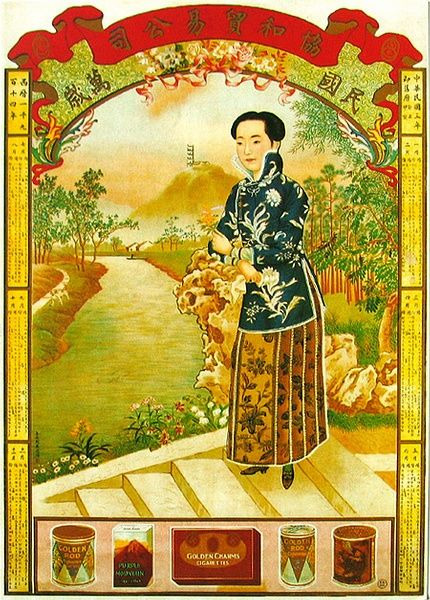
Source here
Calendar painting from 1914. This collar has a rectangular edge and is trimmed with fur.
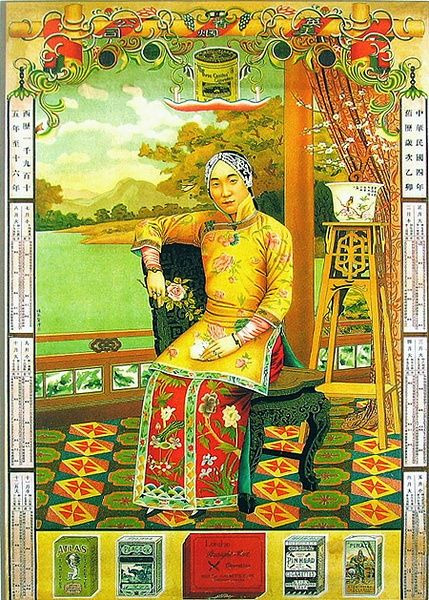
Source here
Calendar painting from 1915-1916. This collar has a rounded edge and wide binding.
However, this ultra tall collar wasn’t everybody’s cup of tea and normal height collars existed as well, especially in the beginning and end of the decade. A new invention of this era was this tall collar with slightly rounded edges closed by two to three pankou----in some extreme cases four. I believe they were stiffened, but even if they were not, the use of wide, heavyweight binding could give it shape and rigidity. This style probably grew out of collar styles 2 and 3 from 19th century Han women’s collars, but it is going to become very iconic and distinct later in the 30s so let’s label it collar style 8. All Han women’s standing collars before the 1970s were extremely fitted, i.e. they completely hug the wearer’s neck and could sometimes be restrictive to neck movement. The loose fitted collars often seen on modern mass produced cheongsam is not historically accurate.
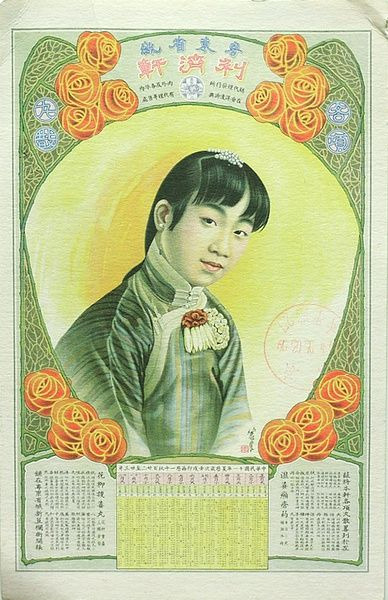
Source here
Calendar painting from 1911 showing collar style 8. It had three pankou, wide double row binding and could be closed at the front.
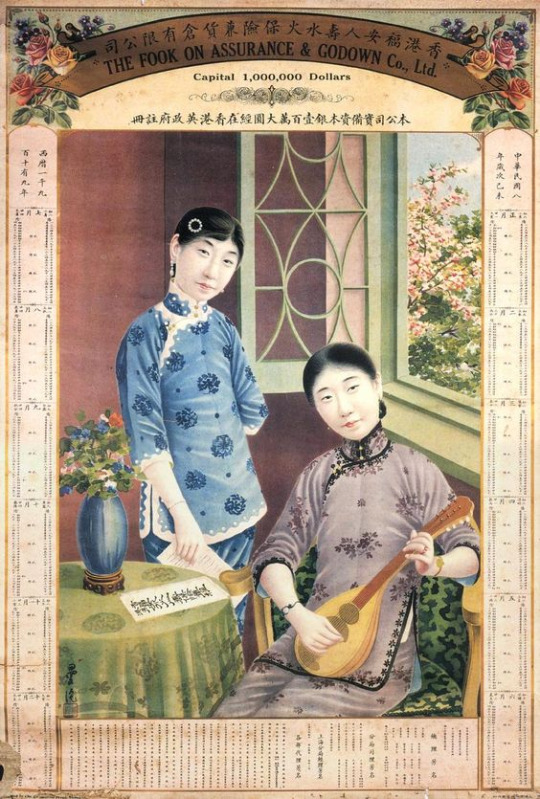
Source here
Calendar painting from 1919 also showing collar style 8. Throughout the 1890s, 1900s, 1910s and early 20s, innovative/Western trims like lace were commonly used instead of plain binding.
Quickly turning our attention to menswear. I’m not a menswear expert so feel free to add info or references. In the 1910s, menswear collars followed a similar development. After looking at more photos from the period, I figured out that in the late 1900s, men’s collars still had rectangular edges and were pretty low. This was also echoed in the formal dress code issued by the republican government in 1912. You can read more about the formal dress code in this article, it’s a great guideline for understanding ceremonial clothing in the republican era.
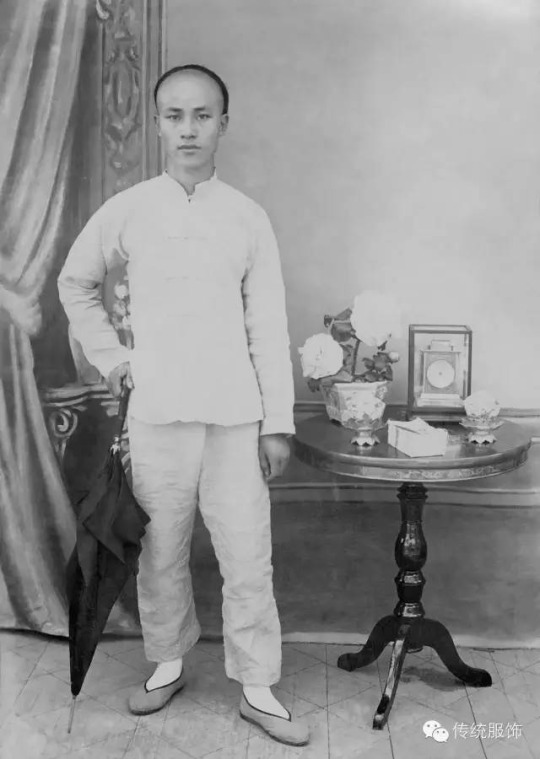
Source here (I’m probably gonna pull most of the menswear photos from the photo album in this article cause they are conveniently dated)
1907 photograph of a certain Mr Ye Jinglv, a legend who preserved his photographs from the 1900s to the 1960s, wearing a 短衫 duanshan short robe and pants.
I have no idea where this collar type came from but the three main suspects are European military uniform collars, Japanese uniform collars (also inspired by European military uniform collars) and Qing Dynasty officials’ collars (now attached to the tunic itself).
As the 1910s progressed, men’s collars gained rounded edges and grew taller just like women’s collars, but they were never so tall to the point that they could not be closed in the front. They were still closed by one plain pankou at the base (men’s pankou has always been plain). This is likely the collar style 6 I identified in part 1 but wasn’t sure about. These collars don’t appear to be stiffened, but rather just constructed of heavyweight fabric similar to the robe itself. Oh and sometimes in photographs you can see men wearing two collars, that is because both the 长衫 changshan, long robe, and 马褂 magua, riding vest, had standing collars in the 1910s, so when both are worn at the same time there will be two collars.
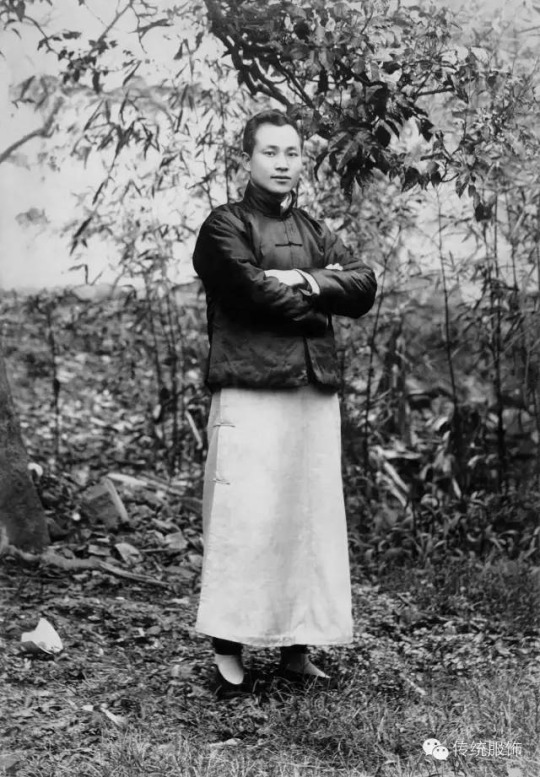
Source here
1916 photograph of Mr Ye Jinglv in a changshan and magua, collar style 6.
1920s
Summary of 1920s Han women’s fashion 1, 2, 3
Going into the 20s collar style 7 went out of fashion completely. The 20s was a wild decade and everything went, but overall collars usually ranged from medium height to tall. There is a wide variety of collar designs in the 20s, women’s dresses with no collar or Western collars like sailor collar, shawl collar or no collar at all etc. all existed, I’ll just list the most common standing collar designs of Chinese origin.
Early 20s collars decreased in height slightly but were still tall standing collars, with rectangular edges, binding and two to three pankous. Let’s call this collar style 9 because it has a will of its own. It’s weirdly reminiscent of collar style 4 from part 1 but the difference is that collar style 4 was unstiffened and had rectangular edges. I don’t think designers in the republican era ever really consciously referenced any historical collar shapes prior to the 19th century... Fashion history was a non-existent academic discipline at that time.

Source here
Calendar painting from 1920 showing collar style 9. It is unstiffened and moderately tall. It has slightly rounded edges, two pankous and a thin row of binding/piping.
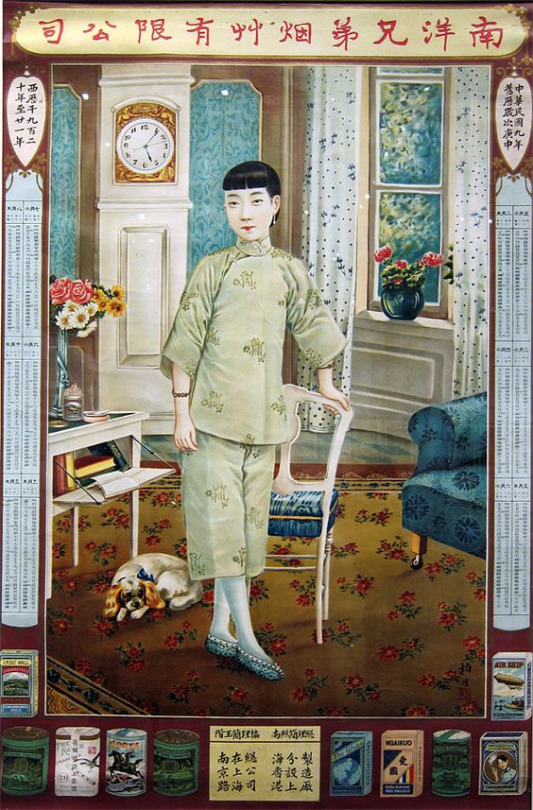
Source here
Calendar painting from 1920-21, showing similar collar style 9 with thin binding and two pankou.
Toward the mid 20s both wide and thin binding could be used and the number of pankou ranged from one to three. I’ve seen multiple times collars with only one pankou at the bottom but still could close completely at the front, which means stiffening was likely used to keep the shape of the collar; I’ll number this collar style 10. The decorations of the mid 20s pursued a tacky aesthetic and were heavily inspired by the 19th century. Alternatively, collars could be decorated with scalloped edges or geometric Western trim. The overall aesthetic was still very 19th century Chinese though. I feel like internal hooks and bars could’ve been used to close these collars, like Western or Japanese military uniform collars, but this is pure speculation.
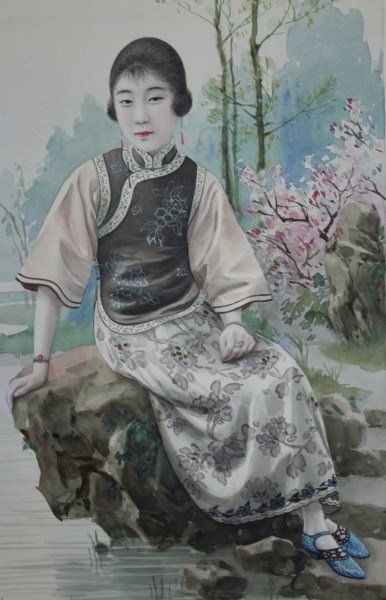
Source here
Watercolor ca. 1926 showing a medium height collar style 10. It closes with only one pankou but holds its shape very well.
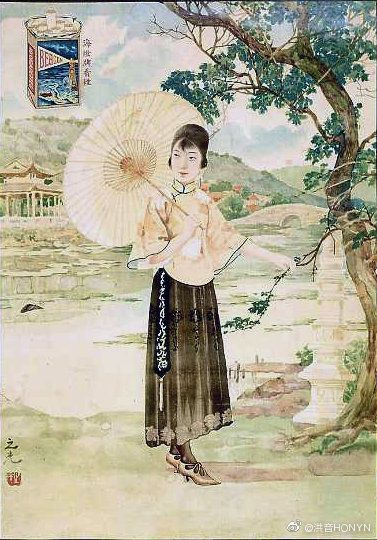
Source here or see watermark
Mid 20s artwork showing a similar collar, albeit with thin binding.
Starting from 1928-29 there was this huge trend of using tall, side closing collars. This collar was stiff and structured, tall and closed at the side or back with either pankou or hooks and eyes/bars. It covers the wearer’s neck completely and doesn’t have any openings. This kind of collar was frequently applied to the newly developed cheongsam, which was a one piece dress, to emulate a Western flapper look. The art deco aesthetic was en vogue in the years 1929-31, so there were many cheongsam with innovative closures instead of pankou. I personally really love this look it’s very underrated. This would be collar style 11; it was truly one of a kind since it was never seen again in Chinese fashion history. Rest in Power.
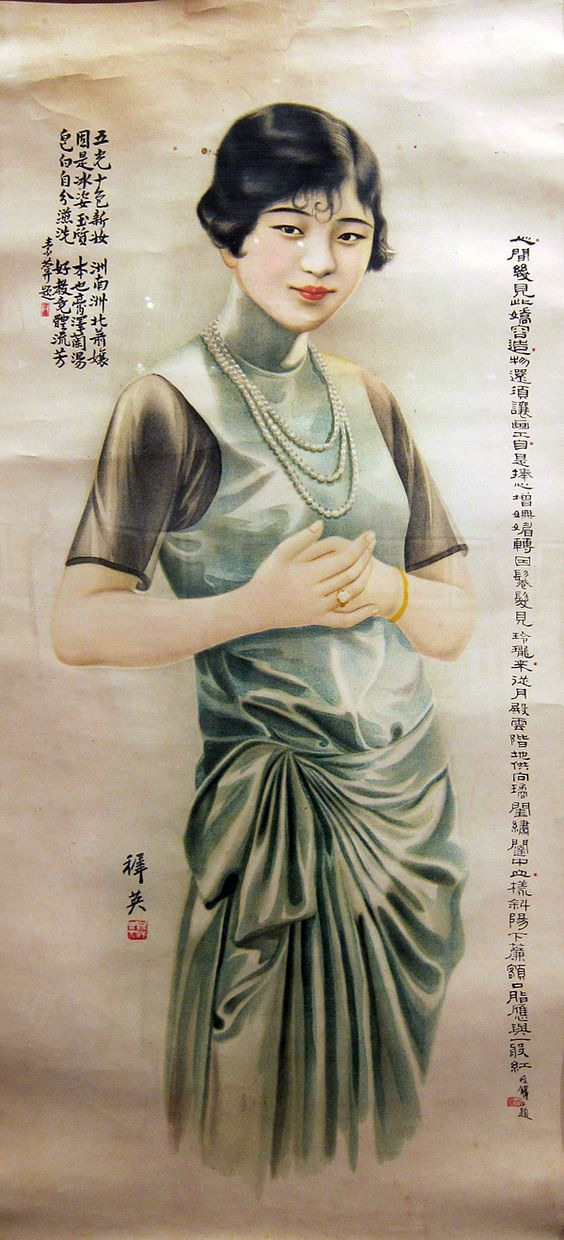
Source here
Painting ca. 1929 showing collar style 11. This is probably closed at the back? Anyway the pankou were not emphasized at this time.

Source here
Kong Sang Hong ad from 1929 showing collar style 11 without visible pankou.
Now menswear again. In the 20s, the tall collar style 6 went out of fashion, following trends in womenswear. The new collar was medium height and still closed by one pankou at the base. It could have either rounded or rectangular edges but rectangular or mostly rectangular edges seem to be more common. I’d say this is similar to collar style 10.
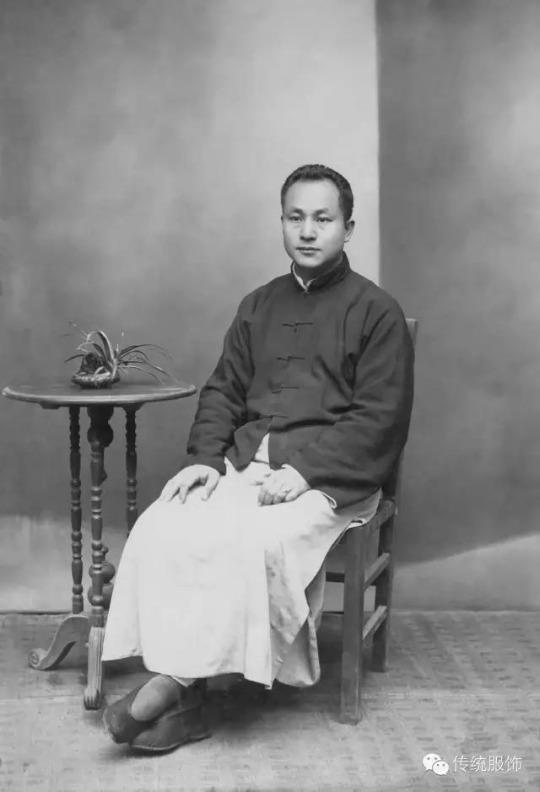
Source here
1925 photograph of Ye Jinglv wearing again changshan and magua.
1930s
Summary of 1930s Han women’s fashion 1, 2
Returning to Han women. Collar 11′s popularity continued to around 1931, when it began to be replaced by a revived version of collar style 8. Collar style 8 with three buttons dominated the majority of the 30s, and these buttons didn’t necessarily have to be pankou; any kind of decorative loop button, clasp or frog closure could be used. 30s collars emphasized the roundness of the buttons, so beads or pearls were commonly used as buttons.
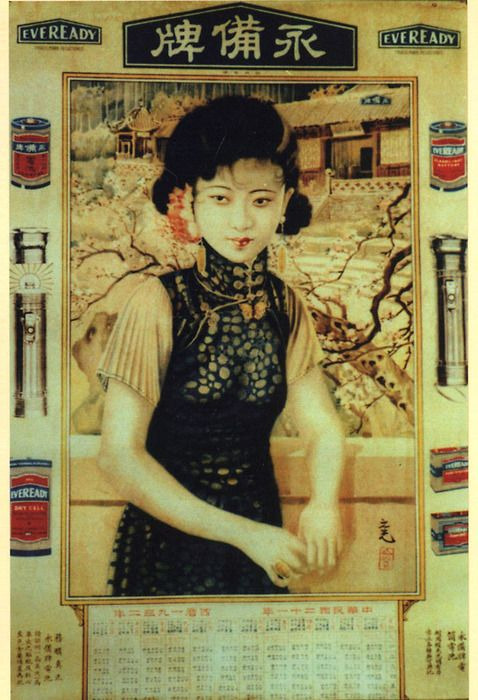
Source here
Calendar painting from 1932 showing collar style 8.
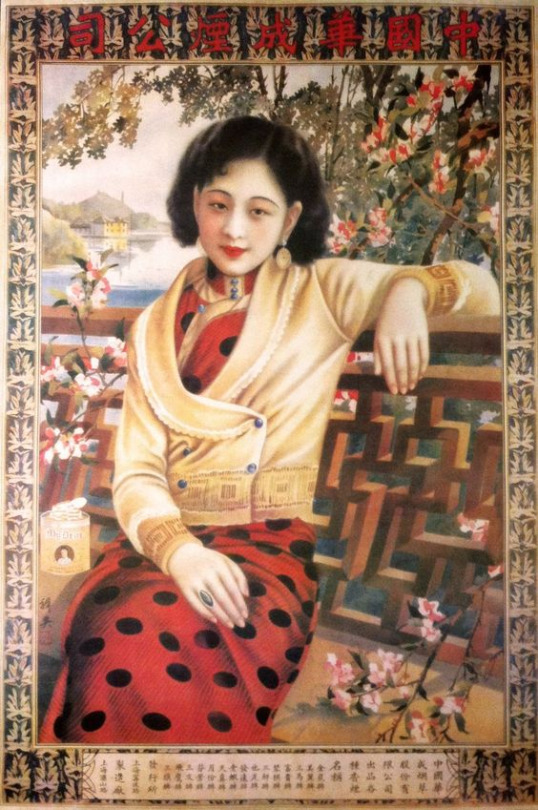
Source here
Mid 30s advertisement showing collar style 8 with bead buttons matching those on the cardigan.
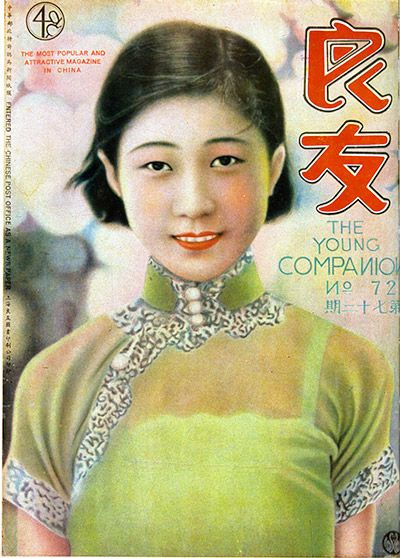
Source here
1932 cover of The Young Companion showing collar style 8 with pearl/bead buttons. Oh collars on a transparent cheongsam would usually be opaque because the interlining/stiffening needs to be hidden.
Men’s collars of the 30s decreased in height again, this time becoming really quite short. Round and rectangular edges coexisted but round edges were still more common. Still closed by one pankou. Not many changes otherwise (gosh, menswear always changes at a glacial pace, y’all men need to step up your game). This foreshadows 40s Han women’s collars so let’s label this collar style 12. Men’s changshan and magua collars stayed this way well into the 40s and 50s.
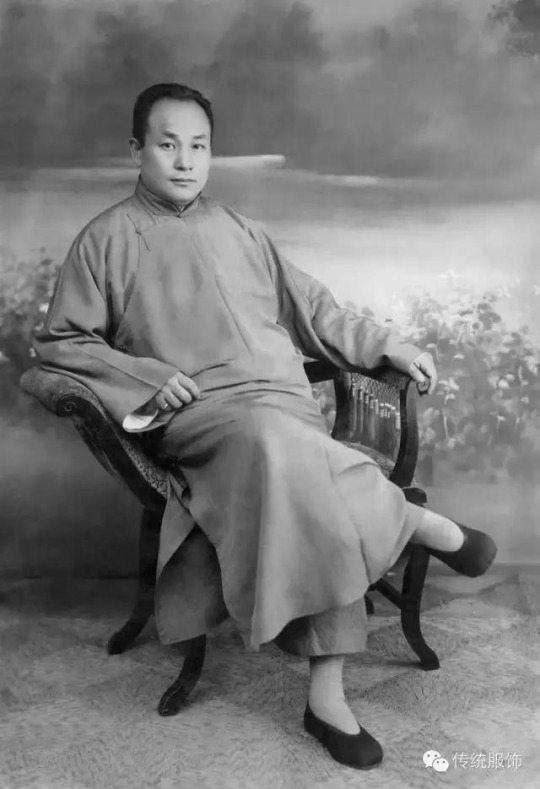
Source here
1935 photograph of Ye Jinglv in changshan with collar style 12.
In the late 30s/early 40s collars dropped in height significantly, regressing to collar styles 9 or 10. It was usually closed with one or two pankou (because there was only enough space for two maximum).
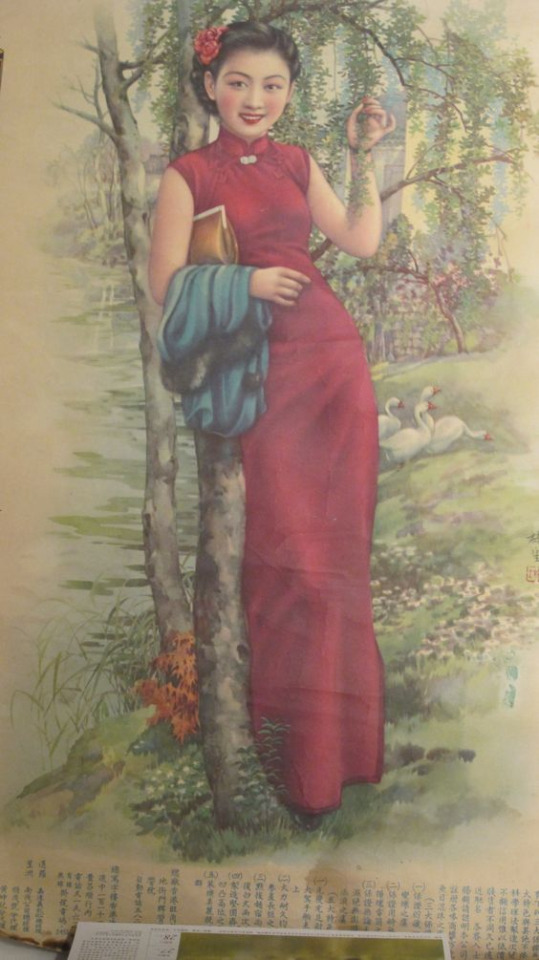
Source here
Late 30s/early 40s artwork depicting the revived collar style 10.
1940s
Summary of 1940s fashion here
As the 40s progressed collars became even shorter, eventually so short that only one pankou could be attached. This developed from collar style 9 but since it was so low and so distinct to the 40s I’d say this is also collar style 12. It may appear similar to collar style 3 from the 19th century but it has rounded edges and is also stiffened and slightly taller.
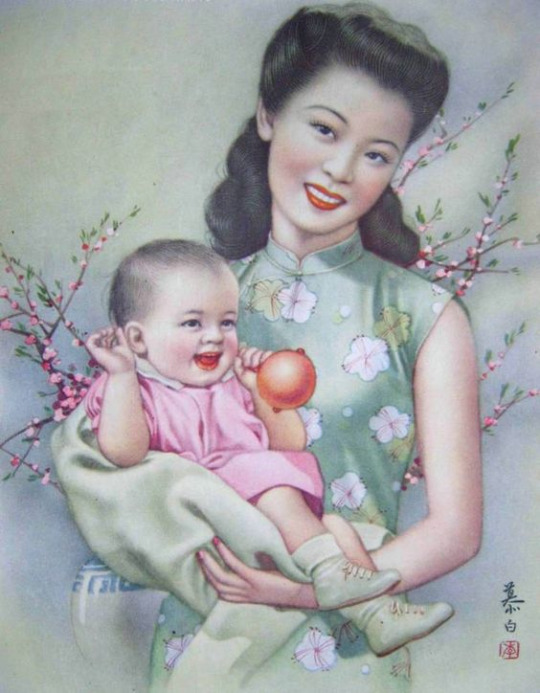
Source here
Early to mid 40s artwork showing collar style 12.
19th century trims became fashionable again in the early 40s, especially collars with multiple rows of binding/piping. However because of scarcity of materials during the war, that style was only ever seen on actresses and celebrities; cheongsam collars for the average woman were plain.
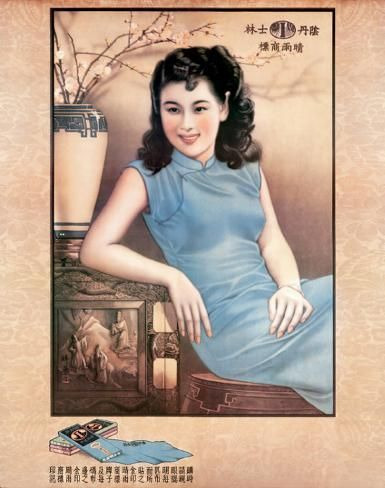
Source here
40s Indanthren fabric ad, showing low collar style 12.
In summary:
Collar style 7: cursed belle époque (ca. 1890-1918) women’s collars that touched the wearer’s face. Extremely tall, stiffened, both rounded and rectangular edges existed. Closed by one pankou at the bottom but sometimes had more pankou for ornamental purposes. Worn by Han women and the plain version for men.
Collar style 8: first appeared in the 1910s, popular in the late 10s and throughout the 30s. As tall as possible without restricting the wearer’s neck movements, stiffened, rounded edges. Closed by two to three pankou. Decorated with wide binding or Western trims like lace in the 10s, multiple rows of binding in the 30s. Worn by Han women.
Collar style 9: developed from collar style 8, popular in the early 20s and late 30s/early 40s. Slightly shorter (medium height), stiffened, rounded edges. Closed by two pankou. Thin binding. Worn by Han women.
Collar style 10: developed from collar style 9, popular in the mid 20s and late 30s/early 40s. Slightly shorter (medium to low height), stiffened, rounded edges. Closed by one pankou at the base. Both wide and thin binding. Worn by Han women and a similar version by men.
Collar style 11: distinctly Western collar, popular 1929-1931. As tall as possible without restricting the wearer’s neck movements, stiffened, rectangular edges. Closed at the side or back with pankou or hooks and eyes. Often plain or of the same fabric as the dress. Worn by Han women.
Collar style 12: developed from collar style 10, popular throughout the 40s. Very short, stiffened, rounded edges. Closed by one pankou at the base. Commonly had thin binding. Worn by Han women and men.
Phew, I thought this was gonna be a short and simple post but it ended up taking way more of my time than I wanted it to. I’m gonna do one last post on the 50s and 60s and maybe address the state of Chinese standing collars nowadays, hopefully that will be actually simple to make lol.
307 notes
·
View notes
Text
Spotlight: Ties That Bind
This one’s a doozy folks! If you missed the last spotlight you can go read it here, but strap in for The Ties That Bind, an absolutely brilliant take on humanformers. It’s hosted here at @tiesthatbind-tf created by @artsy-hobbitses!

Q) Give us a run down of your cont! What's it about, what's it called, what's it like?
Ties That Bind is a humanformers-based original continuity which is part Science Fiction and part Alternate History where the invasion of Quintessons and introduction of their technology to Earth in 1920 sets the world and humankind on a completely different trajectory. The active narrative spans a period from 1920 to 2070, covering the First and Second Quintesson Wars, the interplanetary Antillan War (leading to the creation of Unicron on Mars) and the Great War which involves the Autobots, Decepticons and Functionist stalwarts, and how it affects the characters.
The cast is pretty sprawling and the narrative is mostly centred around human drama with bits of humor interspaced and a dash of horror (mostly centred around how the previous government often chose to utilize the technology left behind from the Quintesson Wars to create new systems of oppression, which affected many of the characters, in the name of worldwide rebuilding efforts).
Q) What characters take the lead here? Any personal favorites?
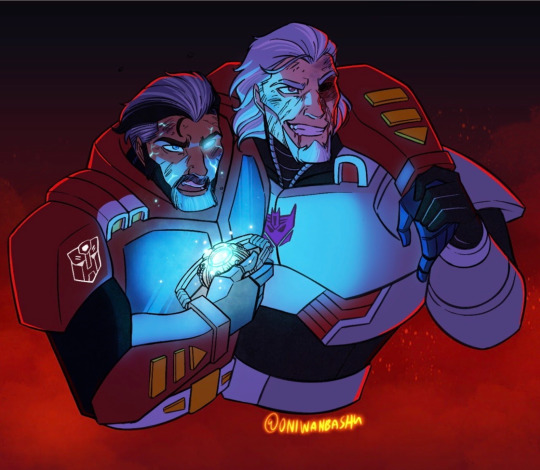
I will admit to this continuity being very much heavy on the relationship between Old Bastards Optimus Prime and Megatron, which is given considerable weight as they were best friends who had known each other since childhood and were deeply intrinsic to each other’s growths as individuals, which makes it all the worse when guilt and betrayal enter the party. Despite being captains in two corners of this battle, there’s a part of them that just cannot let go of their pasts together and they need to reconcile with how this will affect their agenda (Megatron) and how they lead their team (Optimus) who don’t necessarily share their history.
Other characters with significant development include:
Starscream, a Cold Construct in a toxic working relationship with Megatron with whom he is hiding a dark secret, who struggles to balance the underhanded viciousness he believes he needs to gain power and his innate desire from his Senate days to make the world a better place.
Windblade, a Camien native who fights her government’s apathy concerning the situation on Earth which they see as unsalvageable compared to their more Utopian society.
Prowl, a Cold Construct raised from childhood to be a cop in a police state, who finds out that he was brainwashed several times to ensure his obedience and efficacy as a government asset and is now working to reclaim some semblance of the humanity he was never allowed to feel and figure out how much of him is who he really is and how much is programming.
Hound, a sheltered Beastman who joined the fight to ensure that Beastmen the world over would have the same rights he did in his homeland of Shetland Isle, but is forcefully stripped of his humanity and faced with his animal side during the war and has to relearn what personhood means amid his trauma.
Q) Is there a bigger point to this, like a theme or some catharsis? Or is it just fluffy fun?
God with the amount of time I spent sleepless trying to figure out how the logistics of this or the semantics of that were supposed to work in universe, I cannot for the life of me say it’s fluffy fun, but I can’t exactly say it hasn’t been pretty engaging either!
There’s elements of war being messy for everyone involved where there doesn’t seem to be a clear line between friend and foe at times, but I think for most part it prescribes to Jean-Jacques Rousseau’s belief that people are inherently good, but are corrupted by the evils of society. Despite its dark themes (Including but not limited to child abuse, torture, illegal experimenation and brainwashing), love and friendships do prevail, kindness does beget kindness, found families are made, even the smallest actions matter, and things do get better because there are people on both sides who genuinely want to, and strive to make it better.
With Cold Constructs and Beastmen, it also delves heavily into what it means to be human; to have agency and personhood.
There’s also a strong undercurrent of taking responsibility for one’s actions, even if they were made with the best of intentions (Avoidance of this is what eats up Starscream and Megatron from the inside, and what Starscream eventually embraces).
Q) How long have you been working on it?
There’s two answers to this!
I’ve had a Humanformers-related universe going all the way back to 2007 around the time the first Bayformers came out---basically I had a choice between learning to draw cars or draw people (I was an anthro artist back then) and I immediately chose people.
The 2007 draft however had no worldbuilding or connective storylines and was mostly a fun little venture into character design and practice which were actually instrumental to me experimenting and learning how to draw humans properly.
I left the fandom for about a decade and when I came back to it in late 2020 around September via the War for Cybertron series on Netflix, I immediately got hooked on the 2005 IDW comics I missed out on and wanted to get around to updating my old designs as well find a way to translate several of the concepts I wanted to explore in a human sense, so the 2020 update became its own full-fledged original continuity with detailed worldbuilding and history.
You can see the artistic evolution of several characters from their original incarnation below!
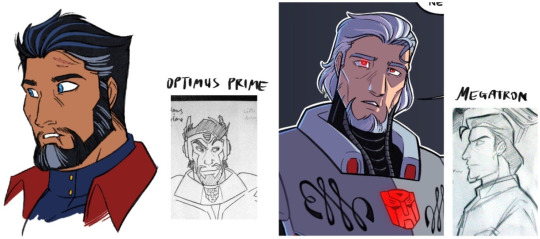


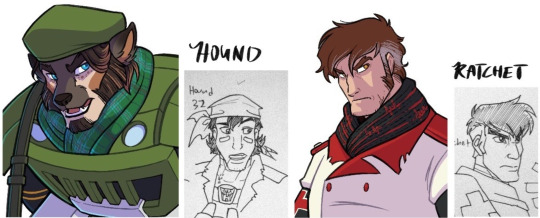
Q) It’s incredible to see your artistic improvement too! Give us a behind-the-scenes look! Show us a secret ;))

Say hello to my workspace! I’ve been working exclusively on the Ipad Pro since late 2016, which is fantastic because I can basically whip up concepts and sketches on the go anywhere. Nowhere is too out of bounds to work on TTB!

Also, do enjoy this sneak peek at true!form Rung, whose synthezoid human body took years to perfect.
Q) YESSSSS alright I must admit this is one of my favorite Rungs, and certainly my fave within TTB. Amazing. Phew, anyway. Where did you draw inspiration from? What canons, what other fiction, what parts of real life?

TTB was initially conceived as a faithful retelling of the IDW 2005 narrative before it was transformed into its own continuity and as such, it borrows heavily from concepts and mirrored plot lines introduced in that run! I chose to have the series inspired off it specifically for the amount of history and worldbuilding it introduced to the franchise.
Anime like Gunslinger Girl and Beastars inspired the depictions of Cold Constructs, especially the more harrowing aspects of their upbringing as government assets instead of children, and Beastmen (Beastformers) in TTB.
I haven’t depicted the world itself in my art all too much, but the architecture from Tiger and Bunny, which has sort of a futuristic Art Deco feel to it, is what you’d usually see in major cities. There is an in-universe reason for that---with a Point Of Divergence set in 1920 followed by 25 years (an entire generation) of progress basically being kicked to the curb due to the Quintesson wars, mankind was basically in a time-locked bubble until the end of the wars, and by then their heroes were 1920s-style rebellion leaders, which lead to 1920s fashion (especially among the Manual Working Class---Megatron, Jazz and Optimus all rock 1920s fashion at some point of their lives) and architecture being celebrated and retained as sort of a reminder of how things were before The Invasion. This anime’s background design is also where I adopted the tiered system TTB’s major metropolises are often built on (with each tier being designated to a different working class) from.
The main artistic style itself is a love letter to 90s cartoons, in particular Gargoyles’ deep and drama-driven character narratives and designs as well as The Centurions’ take on body armor logistics.

I also take inspiration, especially armor-wise, from the characters’ given heritage and background. As an example, Hotrod who is depicted as Irish has the flames on his armor done up with Celtic knots. Welsh aristocrat Mirage’s armor bears olden knight-style filigree and has his Autobot logo designed as a coat of arms. Indonesian Soundwave’s armor and Decepticon logo takes cues from Batik and Wayang Kulit while their mask is based off the Barong.
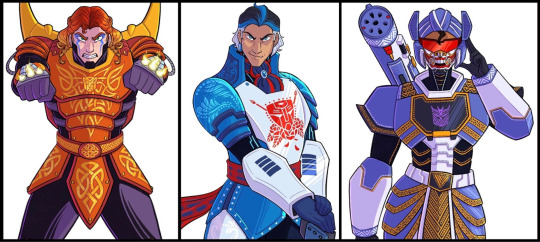
Q) They are absolutely gorgeous! Show off something you're really proud of, a particular favorite part of your cont.
The worldbuilding in general! Most Humanformers I’ve seen tend to treat it like a fun exercise which it is and is definitely valid, but I found myself wanting a full-fledged world to lose myself in and I sought to try and make that world myself by drafting a detailed history and timeline of events which would affect ongoing narratives, having indepth worldbuilding to include almost all societal aspects of the universe and expanding on the concept of Beastmen and Cold Constructs existing in a human setting.
I’m not so secretly proud of the research and diversity included to make the cast look like the multicultural, globally-based team that they were meant to be instead of being locked to a single region! My original draft from 2007 was, to put it simply, quite culturally monolithic and I wanted to improve on that aspect with TTB.
I’m also proud that I’ve kept to it this far! I’m a notoriously flaky person jumping from one idea/fandom to another and to have kept at this continuity for the better part of ten months is honestly a personal feat.
Art-wise, this scene depicting a young Megatron working alongside Terminus and Impactor (cameo by @weapon-up-wallflower‘s OC Missit!) is definitely one of my favorites since it helps build up the world they live in and plays to familial bonds and comfort found in one another despite their less than ideal circumstances.
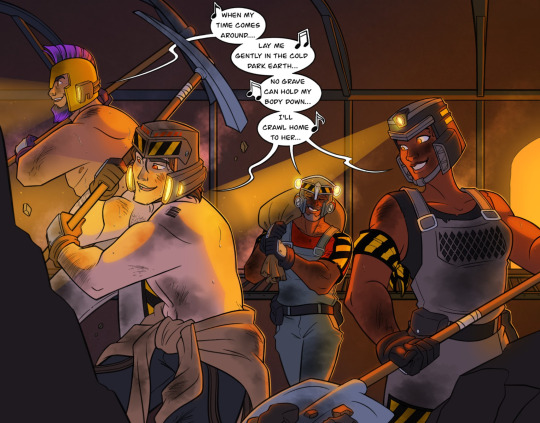
Q) Everything has come together so beautifully, you absolutely should be proud. What other fan canons do you love and why? Would you like to see them interviewed?
I am dying to hear more from @iscaredspider’s Sparkpulse continuity! Her designs are MIND-BLOWINGLY GORGEOUS and I want to hear more about what inspired her to work on it!
Also YOU. Yes YOU BLURRITO. LET ME HEAR MORE ABOUT SNAP.
Q) [wails and squirms away in the mortifying ordeal of being known but in a very flattered way] I WILL SOMEDAY I PROMISE aflghsdjg thank you QwQ
Well that was fantastic, Oni, thank you muchly! A magnificent continuity with so much to look forward to! Coming up next is another personal fave of mine, the first inspiration for SNAP, so stick around...
#long post#gore#ties that bind#spotlight#transformers#HUMANFORMERS#transformers au#tf original continuity#transformers fan continuity#transformers redesign#maccadam#i said id post this on sunday but i realize thats a holiday for lots of folks on this site :/
355 notes
·
View notes
Note
💛 & 📖 for the lovely Alice?
💛- Brotp
Ok, three Brotps come to mind.
The one that has been under the spotlight lately: Andre & Alice, the A-Team of fashion at Hogwarts! Admittedly, Andre plays a big part in the fashion area of that duo, but he does help Alice develop her sense of style. Though it is sometimes against her will 😏
Second Brotp: Alice & Tonks! Another friendship I love writing for, which you can mostly get a glimpse of in my "A Week at Penny’s" series (which is still ongoing). Tonks helps Alice let loose and enjoy just being a teenager, while Alice tries to keep her out of trouble. I love the dynamic between these two.
Final Brotp: Alice & Rowan. Dear Rowan. Alice's first friend, who accepted her even when she was just known as "Jacob's sister" and most people assumed she was just as strange as her brother. Alice and Rowan had similar personalities, both having a love for learning, though Alice didn't mind breaking rules as much as Rowan. You can actually see the hole Rowan left in Alice's life after her death in the fic "Sempre Aqui" from my Brazil series.
📖- AU I’d like to see them in
Oh, that's a tough one. Maybe a mystery novel à la Agatha Christie. I would kill to see Alice help Hercule Poirot solve a murder. (I grew up watching David Suchet's Poirot and would love seeing Alice wearing the fashion of the Art Deco period.)
Another AU I'd like to see Alice in is Sailor Moon. Not as one of the main Sailor Scouts, but maybe a Sailor Scout from a distant planet, or something. (Sailor Moon is my childhood and when my interest in Japan started.)
Thanks for the ask!
#thanks for the ask!#hphm#hphm mc#jacob’s sibling#alice beaumont#hogwarts mystery#hogwarts mystery mc
5 notes
·
View notes
Text
Souly Damned Saturdays!~
🌼Hello everyone! I am excited to share the next SD Saturday! Today is going to be how the Infernal Realm is set up and a profile on one of my favorite boys, Val. This is going to be a huge one! Let’s get into it! If you have any questions please ask away! There is so much to this world and it’s characters that I don’t want to overwhelm people. *again stunning chibi of my boy Val by @little-noko >////< I love it so much*
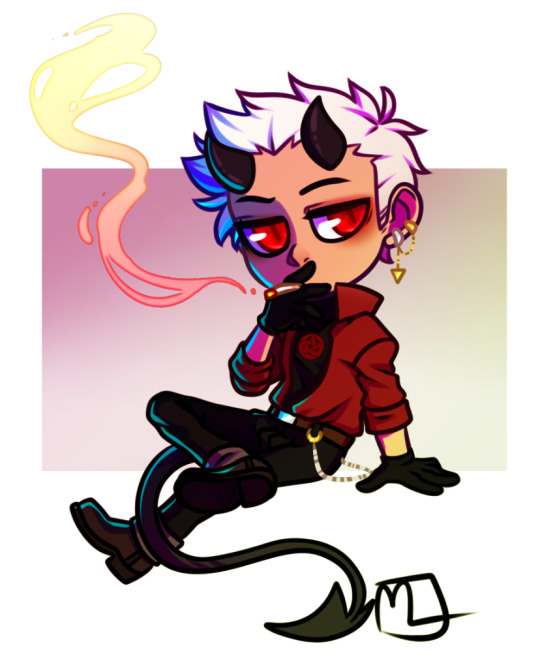
~Prince Profile:~
True Name: Valruth Alias Names: Valentine (Val) Nicknames/Titles: The Bloodstained Beast Soul Flower Type: Rose in half bloom Color Type: Ruby with burnt petals Infernal Hierarchy: 2nd Prince of Lust Age Order: 5th Oldest Familiar Form: White Maine Coon/ (Hellcat) True Form Appearance Description: ~Skeletal in appearance ~Prominent fangs (spiked teeth in true form) ~Ruby pointed tongue ~Black horns that are reminiscent of the stereotypical devil ~Skeletal claws ~Clawed feet ~Spaded bone tail with charcoal gradient ~Golden Fang ~Bone damage (cuts) on forearm, ribs, spine, shoulder blade ~Bone and black feather wings (mix)
Human Form Physical description: ~Hair color: White/ cool platinum ~Hair style: slicked back (before modern and reminiscent of the 1920′s) ~Eye color: Ruby/ reddish brown ~Skin tone: Pale ~Contract symbol mark placement: his left shoulder blade ~Height: 5′9
Special Abilities or Powers:
~Mind reading ~Can pull out deepest desire ~Dream walking ~Mental suggestion ~Levitation ~Teleportation ~Fire element ~Veritas (forces those under his influence to tell the truth) ~Lust touch ~Blood vitality/ power ~Servitude ~Calming/ paralysis touch
(more below the cut!)
~SD Q AND A (These are all questions from you! Specifically those in my server):~
1. What is vals usual duties as a prince of hell? Does he have hobbies he enjoys doing? Does he even like humans if so what does he like about them? 🔥Val has less duties as Costello because even though he is a prince he is not the head of that Kingdom. Though to be fair Costello doesn't really mind doing the work it keeps his mind occupied. Mainly it's Val's job to deal with Coven direction/communication. I mean he has hobbies but uh... those are not appropriate to mention. Remember Val's cardinal sin is lust X'D He does enjoy music so he will spend time learning different musical styles or instruments. All in all he is pretty laid back and enjoys a good time. He’s a party boy, but he will be serious if needed. Costello's position allows Val to be kind of a hedonist. His other job is based in contracts. Most Princes don't directly deal with humans unless circumstances allow due to their past history. It's his job to essentially make sure that quotas are being met. Let's just say he prefers the Mortal Realm because he loves messing with mortals.
2. Does Val prefer like manipulating people or playing pranks more? 🔥 He enjoys manipulating people.
3. How does it feel for Val to take another's life? What did it feel like the first time?
🔥 When he first Fell he struggled with the duality of his Clelestial/Infernal blood. It's the concept of the first life he took was hard on him but the moment he looks at the blood he essentially breaks. After that he gains the nickname of Beast because he revels in the kills. Eventually, he earns the "title" of the Bloodstained Beast which is where Beast comes from.
4. Is Val overall sure of himself or does he struggle with loads of insecurities?
🔥He is sure of himself outwardly but alone not so much. Like I said before the majority of the brothers struggle with what they used to be and what they have become. His father's influence pushed his mind to justify the horrible things he has done. When Darrius is locked away the brothers have to come to terms with the monsters they have become.
5. Does Val ever suffer from depression?
🔥I wouldn't call it depression. It is not that severe. It is more like self doubt or regret.
6. What does it mean to be "alive" for Val?
🔥Unlike Infernals born in that realm, the brothers still have their Celestial souls but they are badly corrupted. Being alive for him is feeling the emotions that he used to when he was a Celestial. Think of their corruption as losing a sense of self. Most think that his "highs" come from drinking, pleasure, and the usual sinful fair but that’s not entirely true.
7. Does Val struggle with who he is?
🔥It depends on what part of the timeline. In the beginning he struggles a lot until he snaps but then doesn't care at all as if his original soul has gone numb. Over the centuries he does begin to mellow out and eventually when he meets Eve he changes his tune. Even before their meeting he is far more self conscious.
8. Do Val’s emotions of himself ever reflect on others or does he keep them tightly wound?
🔥He keeps his emotions tightly wound unless he is with someone he trusts and by god is it hard to gain any of these boys trust. They were betrayed by their father and their other family... so they have major abandonment and trust issues.
9. Has there ever been a time where Val considered "love" over "lust"?
🔥Yes! In fact that is what he used to be. He was a Celestial of love and affection. It is one of the reasons that I made his alias name Valentine. Eve is the love of his life and he treats her as such.
10. If the brothers get their hands on souls what do they do with them? Will each prince treat souls differently from one another?
🔥Soul wise they can consume souls for their power, which they are already ungodly powerful already. The only caveat to that is that it corrupts their souls further. Sometimes those souls end up tormenting them for a while before they fade away. Each one has a different effect depending on the soul itself not so much the one who consumes it.
11. What happens to changelings that die? Do they become infernal beasts/imps? or does something else happen?
🔥They essentially meet a permanent end, however, I should mention that they kind of get recycled in a way? Think of it as giving the energy back to the realm. It strengthens it. There are various artifacts and runes of great power strewn throughout the realm that are powered by dead Infernal life forces.
~The Infernal Realm Info~
General Structure:
The Infernal Realm is divided into an odd configuration that would imply something along the lines of Dante’s Inferno but the rings do not consecutively branch out. In the center the Infernal Palace in the capital city of Eden rests surrounded by the homes and residences of the Infernal elite. The ring outside those gates consists of five kingdoms; Lust (being the largest of the five), Pride, Greed, Envy, and Wrath.
The outer most ring consists of the other 2 kingdoms; Sloth and Gluttony. Lastly the outer “walls” or ring is a wasteland for lost souls that neither belong in Heaven or Hell. This is what most would consider to be Purgatory but that would be factually incorrect. The gateway to purgatory is hidden within this land's monochrome and misty forests. There are also rumors that a gateway to the other realms also lies in these woods safely guarded by Infernal Beasts with loyalty to their King. There is in fact a portal to the mortal realm in each kingdom and heavily guarded by whoever each Prince sees fit. In the beginning of their banishment the Princes began to build on the outskirts of the realm working their way inward this causes an influence on the architectural influences. The further out the kingdom the the more ancient. SO each Kingdom is influenced by a specific period in time. This also coincides with the technology seen in the kingdom. The exception are the Prince’s castles. An example of this is Gin’s Kingdom of Sloth. His kingdom is heavily ancient Egyptian based but he is obsessed with the mortal realm so he still has technology but you can only find it in his “castle”. You wouldn’t see that kind of tech outside those walls. In addition each kingdom is divided by a dangerous wasteland in order to deter souls from trying to escape kingdoms.
The only means of travel is a railway that travels from kingdom to kingdom. The tracks move and shift (kind of like the stairs in Harry Potter) to the destination that is required. One needs a ticket otherwise you can’t get on the railway and this is generally used by Imps or the occasional changeling if they are given permission to do so.
Darrius’ Prison (The Wasted Hollow): Darrius is locked in a very specific prison stuck in between the Infernal and the Mortal Realm. It's a cushy small cage that can only be opened by the power of the 12 Princes. There is not a living soul in it except for him. This place dampens his abilities but they all cannot be contained. He has imparted his influence in multiple ways by reaching out to mortals and demons alike. Under his instruction they have created different cults. They are currently clandestine under the New Order and the New Mortal Realm.
Note: If it was possible to get an aerial view of the entire Infernal Realm it would look very similar to a contract symbol or in essence a seal. This is due to the railway system that connects the kingdoms together. It’s a relatively new future as the millennia have progressed but the formation of these lines is in fact in the shape of a pentagram.
~The Kingdoms (7)~
Lust (Inner Ring)- The kingdom that used to be ruled by the current King of the Realm. The hierarchy works that each kingdom rules over a certain sin committed by those punished. The closer that they are to The Capital the richer and more prosperous. It’s era of influence is the Roaring 20′s and that can be seen in it’s more art deco styled architecture and fashion sense. The lust kingdom is ruled by Costello who is the crown prince and following that is Val. He is a prince as well but uncrowned to one of the major kingdoms (he could honestly care less).The kingdom of lust revels in opulence and is known for its material wealth and the demons here tend to be debaucherous and are known for their slave/pet dealings. In this kingdom they tend to be overly needy causing them to sate their desires with damned souls or each-other. It is well known that nothing can really saite these demons appetites for pleasure. They do as they will but continue to follow under the rules set forth by the King. The demons of this kingdom however tend to get away with more considering their kingdoms standing. Lust also does not just account for physical pleasure but lust for things such as wealth or power are prime examples. It is rumored that the two brothers appear to be opposites in their handling of the sin. Costello being more about possession and passion while Beast is more the stereotypical lust. Out of all the kingdoms this one seems to be the “best” one to be sentenced to especially if you find yourself at the feet of its rulers. The humans here are usually taken care of quite nicely though it is also rumored that some of those souls in question do not belong in Hell at all. Appearance wise the Lust kingdoms Castle is paved with marble and gold. It is near spotless excluding wealth and grandeur. The massive walls that hide the Castle from view are covered in thick lush green vines and flowers. They have lace like porticos that spill a strange liquid from snake-like mouths. It is said that a human that even consumes a drop of it will be subject to their demon masters will for eternity. A strong manipulative love potion in essence. The Palace gardens are almost as if they were taken from the Garden of Eden itself which is entirely possible. The further away from the epicenter of the city becomes less ostentatious though not dilapidated by any means. Many of the Infernal elite live in this kingdom commonly.
Pride (Inner Ring)- The kingdom of Pride is ruled by Carthus and Dusk which resides in the inner ring. As such it too exudes opulence at its center. The Kingdom supplies and trains those for the Capitals personal guard as well as the demons that are considered soldiers. This is also the Kingdom of the tainted. Those that are not quite demon but also not quite human. A long time ago when demons walked among the humans in the first mortal realm they wrecked havoc. The Princes of Pride manipulated humanity so much so that they began to turn them away from their old religions so that they would worship them instead.
In turn the two brothers (along with the Princes of the Kingdom of Greed) toyed with human souls creating Infernal half breeds. What humanity calls vampires, werewolves, and so forth. The humans began to decline at rapid numbers since those of half Infernal blood easily hunted the weak. Now they span the wasteland of Purgatory sometimes finding themselves in the Infernal or Mortal Realms.
Humans of high status on earth are also subjected to the same kind of torment they put on others in the worst way possible. Dictators, murderers and the like in this kingdom. It is a series of mind altering and psychologically torturing pathways and darkness. The only ones that are able to navigate this kingdom are those born from it’s depths or the Princes themselves as Dusk is the one that devised this horrifying MC Esher maze. It is influenced by the Late Victorian and Edwardian period. This kingdom’s seasons and magically produced light source can vary but the majority of the time the skies resemble twilight fading into darkness as you get further away from the castle.
Wrath (Inner Ring)- The Kingdom of Wrath is the kingdom of War and bloodlust ruled by Sokan and Azrin. This is the kingdom known as The Cell unlike the kingdom of Lust, Wrath only shows off it’s splendor near it’s castle and some of the surrounding areas. It is mostly utilized as a giant torture pit. This is where souls are sent as punishment of the most severe crimes and tortured mercilessly sometimes torn to shreds only to be revived.
Their leader is a ruthless warden of sorts making sure that everyone obeys the laws both set forth for demon or soul. Demons sentenced to exile are also detained here in this confusing catacomb prison. It is filled with deadly traps and pitfalls to prevent escape as well. The human souls usually sentenced here were the warriors that committed atrocities without a second glance at the innocent. Those that killed children in the name of the king is an example of this.
The Cell is also where souls are twisted beyond recognition and where most new demons are made. In this world demons are made not born and those corrupted souls become the new generation. It could take years. It could take centuries but being thrown into The Cell is a sure fire sentence into Infernal rebirth.
There are two rulers of this kingdom and as such two types of punishments. While Boss rules over the Pit, Azrin is his little torture aficionado. Those sentenced are usually the type of killers that were mentally undone. Ones that took a sick twisted pleasure in their artistry. Those are usually brought from the outside. Their ruler, Azrin, is what one might call… unhinged at best. They are known for their experimentation attempting to twist mortal souls into whatever is desired... following in the footsteps of his older brothers.
Greed (Inner Ring)- The kingdom of Greed is unlike any other kingdom as it houses an insurmountable number of souls within it (even if they don’t last long). It’s influence is the High Gothic Period, just think Dracula’s castle and forest. The ruler of Greed, Crimson, is a ruthless warlord with an unusual thirst for blood and not in the war hungry way. It’s second Prince, Grimm, enjoys torturing souls himself and will generally set up elaborate hunts to that end.
It’s alternate title is that of the Kingdom of Blood. Those unfortunate souls forced to end up in such a horrible kingdom will find themselves subject to experimentation or unwinable hunts. Crimson was the one that started all of this half breed creation along with Carthus and Dusk. Though there were many creatures that came about through this experimentation Crimson and Grimm are specifically tied to two infernal blooded hybrids. The two brothers are most likely where the vampire and werewolf mythology stem from.
Both brothers continue to play with their human “toys” as they did so long ago. They enjoy the thrill of hunting down those sentenced and revel in their success. Crimson prefers the opulence and riches that his sin provides while Grimm is more down to earth. It may account for his more bestial nature as he has a similar animalistic inclination like that of his youngest brother Ouro.
Envy (Inner Ring)- This is the kingdom that trains and outsources spies as well as assassins. Demonic hitmen used to gain political power among their respective kingdoms. They are known for their thieves mostly stealing from their neighboring kingdom of greed, specifically souls. Envy is known as the shadow kingdom usually housing those souls of the occult and black magic. Those that tried to obtain the unobtainable through magical or demonic means like that of Hedge Witches.
Sanneth does not take kindly to this as these souls are tortured for all eternity forced to relive and conjure their own worst fears or transgressions. A never ending nightmare would be an apt description. Like his younger brother Dusk, Sanneth does not embrace his sin as much as the others. His abilities reflect his more Celestial blood but alas he is a Prince and therefore a kingdom he must rule.
Sanneth also happens to be the twin brother of Carthus and the two are constantly at odds. He believes that they can conduct their “duty” without fulling turning into monsters while Carthus revels in his corruption. The 4th eldest prince’s envy could stem from his desire to return to how he once was. The castle rests in a season of eternal Spring influenced by the Japanese Edo period.
Gluttony (Outer Ring)- Those that are placed into this kingdom as punishment are subjected to torture of starvation and thirst. The princes castle is surrounded by a never ending desert with no hope for food or drink. Souls are forced to starve wandering this desert for the rest of eternity. The demons banished into this place feast on mortal corpses that fall, tearing them to pieces like scavengers.
When the sun sets these mortals end up back where they started in one piece having to endure the same torture over and over. Ouro the ruler of his kingdom does not do much in the way of duty. He tends to delegate his jobs to other lower level demons. If a mortal manages to cross the desert the torture is with standing. Any food will turn to ash in their mouths and any water will burn the throat. It is an endless never quenchable thirst and hunger. It’s influence is that of Mesoamerica such as the ancient Maya and Aztec civilizations. Sloth (Outer Ring)- Sloth is the final kingdom before the Outer Ring. It is “ruled” by Prince Gin though no one could actually tell you what it takes to maintain the kingdom as he tends to delegate everything to his Dukes.
The souls here are never allowed to rest, forced to work the land for food production. Which is hilarious because food does literally nothing for demons. Ok hilarious in a cruel sick way. The Infernal Princes do like to have their feasts and lavish parties but that food is very different. In essence mortals are forced into a constant state of fatigue. Never able to drink, eat, or most of all sleep.
Gin tends to be selectively lazy but he has a fascination with the modern mortal world and tends to spend a lot of his time acquiring items from there. The poor boy has insomnia so he rarely sleeps since he is so enthralled with his game systems. He is very much a pop culture nerd at times and if you can get on his good side you will find that is probably one of the softer of the Princes. He likes a good time, oh and junk food... lots of junk food. The influence for this kingdom is ancient Egyptian as alluded to earlier since both of the Outer Ring Kingdoms are surrounded by a seemingly never ending stretch of desert.
(That’s it for this week! I hope that gives you all kind of an idea how the Infernal realm works. This is jus the basics and if people are more interested in this I will go into more detail. That is what the ask box is for!) << PREV | FIRST | NEXT >>
#Souly Damned#SD Saturdays#worldbuilding#info#askbox is open#original content#demons#angels#Valruth#Valentine
25 notes
·
View notes
Text
The Timeless Allure of Jalan Braga


Modernity has changed this street to a newer and fresher look but somehow, it is about the way you take a step then you feel the historical sense along the way.
November 1, 2021
There is always something interesting about this street. Among its changes from the old looks to the modern one, Jalan Braga still has a charm that is not possessed in other tourist attractions. The main road that always attracts the attention of both local and foreign tourists indeed holds a lot of history and is a silent witness of the Dutch colonial period also became the beginning of the city of Bandung, dubbed Paris Van Java. I was having a very short trip to this place last week, an unplanned one actually. It’s been a while since my last visit but things just changed a bit. Except for the crowd, I think it’s getting more people each day.
For me, srolling around this street feels like taking a step back in time: a narrow street with many art-deco buildings from the early twentieth century. It is kind of refreshing to see some of these old buildings had been renovated back to their old glory. Modernity has changed this street to a newer and fresher look but somehow, it is about the way you take a step in this street then you will feel the historical sense along the way.
Jalan Braga, with a length of 700 meters, not only offers historical tourism but is also expanding with numerous culinary tours of ancient and modern culinary, arts and souvenir tours, to the city of Bandung's nightlife core. Coffee shops are everywhere. It’s like they are only separated by one or two different kind of stores. Korean food restaurants are also that easy to find. I think this is how the trend takes over the changes of the street’s look. Even though there are still a lot of street vendors who sell local specialties, I can see that the modern places gain more visitors than the ancient ones. However, although modernity has dominated this place, but I still see visitors must take photos at all corners of Jalan Braga that are identical to the unique colonial buildings and I think the peculiarity of Jalan Braga is what makes it a symbol of Bandung and keeps people coming back.
The weather was very cold at that time because I visited another place first before I came to this street at night and the city was poured by rain since afternoon. It made me don’t have much time to visit many places. But I found Sweet Cantina. It was an ice cream shop and yes, did not match the weather at all. It was cold but people kept queueing in front of the storefront. My curiosity led me to have a cone. Once again, it did not match the weather but the ice cream taste was so good. I tried the cookies and cream flavor while two of my friends had greentea and dark chocolate. I can conclude that this is a must try to every sweet tooth out there.
Another interesting yet iconic thing to find is you will see many paintings are displayed in front of several closed buildings along the street. Although selling any merchandise on a pedestrian walk is prohibited in Bandung, the only exception is these painters. They have been in this street for who knows how many years. The paintings are mostly large-sized and surely they are beautiful. It looks like they are part of the street decorations.
Even though Jalan Braga is now becoming more modern, the colonial atmosphere is still felt due to to the many shops with typical building designs of that era. It will will certainly bring visitors to feel like they were in the past. Lastly, Jalan Braga is also surrounded by historic areas such as Gedung Merdeka, Museum of the Asian-African Conference, Bandung City Square, Point 0 (Zero) of Bandung City, and others. Therefore, you can freely walk to enjoy Jalan Braga and surrounding areas to get to know the history of Bandung itself.
2 notes
·
View notes
Text
Dance of the Spheres Chapter 5: Martian March
Chapters: 5/?
Fandom: Marvel Cinematic Universe
Rating: PG 13
Warnings: drugging, kidnapping, forced marriage
Characters: Loki(Marvel),
Additional Tags: Loki Goes Overboard, But When Doesn’t Loki go Overboard, Mature Reader, Disabled Reader, Political Intrigue
Summary:
I'm going back to Saturn where the rings all glow
Rainbow, moonbeams, and orange snow
On Saturn, people live to be two hundred and five
Going back to Saturn where the people smile.
Saturn-Stevie Wonder
our rooms glittered. They were faced in massive scale pietra dura stone patterns from floor to ceiling. Gray, black, and white dominated, with a surprising amount of green mixed in, as well as startling pops of orange-red, blue, yellow, purple, and bright pink.
The designs were large and geometric, almost a sister style to the classic Art Deco that you saw on the older buildings downtown, mixed in among the flavorless glass towers and Brutalist boxes that defined the 'modern' era.
This main room housed a delicately carved stone couch and chairs, around a low stone table, and several stone shelves and storage boxes. These were all made of a black stone that held numerous yellowish-green crystals in their matrix, all polished so that the crystals shimmered.
This same stone appeared in the patterns on the walls and floor, as very thin panes on a pale backing, highlighting the colors of their crystals. This, along with a similar black stone with reddish-orange crystals, and a dark gray, large-grained stone that sparkled at any angle, was contrasted against the now familiar creamy white and pale orange. Here and there, inlays of silvery wire brought organic shapes to the mix.
The cloudy crystal made a reappearance in a round, well-lit, domed room Loki described as a 'Solar', even though no sun could reach this place. Instead, the clearest of the crystal had been set into the dome, all of it covering the mysterious lights, creating a bright light source that illuminated the room to something close to midday. The walls were covered in the cloudy crystal, which, in the bright light, shone with veils and flashes of iridescent blue.
On one wall there was a subtle inlay of translucent gray stone, in the shape of clouds, that shone in splashes of blue and purple. Cleverly inlaid within them were specific pieces of the same type of stone, in the shape of lightning bolts that sparked yellow when viewed at the right angle, but were invisible from others.
He showed you the antechamber that connected your rooms and his, all in black and green. Even the lights were covered in thin panes of green crystals thickly packed in black matrix, casting a dim, viridian light over the whole chamber.
You decided that room was extremely creepy, and you never wanted to be in it.
The bath room was much better, ridiculously large, with a shower just out in the open, a wide counter with a mirror of polished metal, a huge tub carved right into a semi-finished block of stone, and a strange toilet tucked away in a stall in the corner. It was all big enough for you to move around in easily, though you mentioned that you would need a chair for the shower. Loki vowed to have one brought immediately.
But your bedroom was the obvious jewel. Loki puffed up with pride as he showed it off, as if he were the one who designed it. There were jewels in here, bright, bubblegum pink, golden yellow, and apple green in elaborate platinum settings, affixed to the walls. There was more cloudy gray and white crystal in here, with their blue and purple, pink and yellow flashes. The lights were clustered around the ceiling like stars, and the bed was another of the precious rare wooden objects, a four poster canopy bed, draped with a gauzy veil.
Most surprising of all, the bedroom had a window-or rather, a doorway out to a semi-circular balcony that overlooked what must be the main palace courtyard and entrance. When you stepped out onto it, you could see lines of guards-more people than you'd seen in one place since you'd been here. They framed the long, rectangular space every ten feet or so, in bright, brassy armor and sunny yellow capes.
This was clearly a cape kind of place.
It was very strange. You could have sworn you hadn't climbed any ramps, and you certainly hadn't gone up any stairs, but here you were, at least six stories up, and there were more stories above you.
“You must be clever builders.” you said without thinking about it.
“Our engineering capabilities are the envy of the galaxy, it's true.” Loki boasted. You believed him. All around the courtyard more balconies jutted out. Several dozen feet to the side of yours, the balcony you assumed must belong to Loki was connected to another large balcony on the opposite side by an elegant walkway, supported by slender pillars. There was a round platform in the center, and red curtains obscured the balcony on the other side.
“We can address large crowds from there, or call emergency meetings of the guards, or the other high nobles.” Loki said, following your gaze. “That's who lives on this floor. Myself, my brother, all of the most important Asgardians, and now you.”
But not for long, if you had any opportunity. “Uh, I'm honored.”
“How do you like them, though?” he pressed, “Is the décor to your liking? The size? We've been working on it for months, but we can still change things if you need.”
“Months?” you gasped, shocked. “You guys did all this in just months?”
Asgard had come to Earth a little under two years ago, decimated and begging for assistance. Thor led them, but no one knew Loki had come along. Thor himself served as his own liaison to the United Nations, bringing his case before the leaders of Earth, to secure a place for his people.
Obviously, it had worked. Thor's reputation and high-profile friends, as well as his surprisingly diplomatic and optimistic outlook had both charmed and discombobulated most people who spoke to him. People liked and respected him, but no one expected him to be savvy.
It had worked out very well for him and his people. They had secured some secret land that the entire U.N. had remained tight-lipped about. Then, a few months in, Thor had stopped making appearances, leaving Earth-Asgard relations to his advisors; an abrasive, undiplomatic woman whom you loved to watch, and a stoic and imposing man with unsettling eyes. Rumors flew for a while, but you hadn't paid much attention. There had been so much to fight for at home.
Did anyone even know you were gone? You were supposed to attend a march tonight. Or last night? You didn't know how long you had been asleep. Surely someone noticed you were missing.
But if they did, how would you even know?
“-harness the sun's energy over the long rotation period so that we can build even more efficiently.” Loki was saying. “We've done an admirable job for such a reduced population, but there is so much more to do.”
“And you took them away from that to build this for me?”
“I took them away from this to build special chambers for the princess of Asgard.” Loki corrected, “It was not a waste, nor was it superfluous. It was for someone important.”
“I'm not.” you insisted, “I'm just some rando they snatched up and tossed at you. I'm not princess material.”
“I will find out what is behind this.” he said, “But until I can, I want you to feel comfortable here. This is all yours now, and more.”
You couldn't, you couldn't allow yourself. You weren't supposed to be here. It was only a matter of time before this mix up was discovered, and a swap was arranged. You'd go home, and some other woman would take your place.
How horrible.
“But is everything to your liking? Do you need more light? More space? Is the bed all right for your leg? A good height?”
You were more than a little wary about getting into bed with him here, but as you hobbled over to it, he remained at a distance. You sank onto the plush mattress, with it's silky green sheets and thick comforter. It was very nice, soft and smooth, and warm, despite being placed on solid stone. Hopefully the blanket would ward off the slight chill that followed everywhere you had been so far.
“It's a good height,” you said, “especially if I get a new cane.”
“Excellent. Would you like to see my quarters?' he asked, “You may come and go between them as you please.”
Which meant that he could too. You didn't find that reassuring.
“Uh...isn't that, um, inappropriate?” you asked, casting about for any reason to refuse. “We haven't even, um, there hasn't even been a wedding!”
He paused, then his face broke into a beautiful, glowing smile. “Of course. I understand. You want that big celebration, naturally. Well, it is only fair, isn't it?” He sat down on the floor next to your bed, as if forgetting that he was a prince and a god, a powerful figure, abandoning his dignity to sit on the floor like a child.
“Do you want to plan it, or leave it to the advisors? Asgard is very good at grand weddings, but if you've had some specific plan for it, I'm sure we can accommodate it.”
“Uh...” This would be the perfect opportunity to stall. You could buy so much time with this! “I would like to plan it. There's things I've been wanting to do since I was a little girl. It would be a dream come true, to plan my own wedding.”
Not strictly true. Certainly, as a little girl you had contemplated flowers and a dress. There being a groom was far less important.
“Then begin any time you like.” Loki said warmly. “I'll have notebooks brought to you, and you can plan out whatever you want. Whatever it is, we can do it for you.”
You almost felt bad for what you were going to do, but on the other hand, you didn't trust him and his terrifying adoration, and horrible power over your life and safety. You'd make as many impossible demands and take up as much time as you possibly could. If it kept you safe. If it kept you from the nightmare scenario.
“I will have your bathing chair brought. You seem tired; shall I have dinner brought to you? We can dine in your audience room. We can have you measured for a new prosthetic, and for a new cane as well. The artificers will set to work on them immediately.”
“Um, sure. That sounds fine.” Dinner would be welcome, after only one apple and one cup of water. And a new, higher tech leg and cane might help you escape faster. You should take every opportunity available to you.
Loki helped you out to the largest room, with it's bookshelves and seating, and saw that you were comfortable. Then he bid you stay put and wait for a bit, while he got everything set up. You were in no shape to try for an escape right now; you would just bide your time.
You waited patiently, taking in the details of the beautifully precise stonework that made up your new-temporary-living quarters. What incredible workmanship. Shame it had been wasted on you.
Maybe someone else would have been thrilled. To have wealth and power, security and luxury, a handsome prince just handed to them with no effort on their part at all. That wasn't what you wanted though; you didn't want to join the lucky ones. You didn't want to be lifted out of your hardships and set above your peers, you wanted those hardships to be eliminated for everybody. You didn't want to be a social climber, you wanted a more equitable society. This fantasy was worthless to you. It had all been done without your consent.
A quiet knock on the door grabbed your attention. You didn't answer immediately, and the knock was hesitantly repeated.
“Um, come in?” you called.
The two adolescents you had run off before cracked the door open and peeked their heads in.
“Your highness?” the girl asked.
“May we enter?” the boy finished.
“Yeah, come in. I'm in a better mood now.” you said calmly. No need to be rude to them now that she knew what was going on. If Loki hadn't even known about the kidnapping, there was no way these kids were in on it.
“We were sent here to get measurements?” the boy-Andvarri wasn't it-asked shyly. “For a prosthetic leg, and a cane?”
“Yes, I was told you might be coming. I'm sorry about earlier: I was very disoriented and confused.”
“No harm done, your highness. This won't take long.”
The girl-Bjarkehilde-helped you stand as Andvarri took several measurements and asked about your preferences in weight and materials, flexibility and points of articulation, even colors and decorations.
They were going to put in a lot of effort to help you escape. A fine efficient leg, a sturdy lightweight cane, and Bjarkehilde even asked about what kinds of medication you needed, and for what.
Bjarkehild was surprisingly close to your height and build as well. That stayed in the back of your mind for a while after the two of them left.
As the minutes passed, you began to realize that you were going to need some kind of clock. You had no idea what time it was. There was no visible sunlight, the lights in your rooms hadn't changed at all, and no one had mentioned it at all. How did the Asgardians know? Was some kind of internal timekeeping part of their natural abilities?
Maybe it was the nebulous grasp of time, maybe it was the fading adrenaline and setting in of weariness, maybe it was residual drugs working their way out of your systems, but you began to feel strange as you waited for Loki to return. Either you felt hot, or the slight chill that was prevalent in this place was getting worse. Perhaps you had been staring at the artistic walls for too long, because the colors seemed to be vacillating between painfully saturated, and fuzzy at the edges.
It seemed to take forever for Loki to return, carrying a tray of food and drink. This he set on the lovely stone table before you, and then took a seat in a nearby chair.
“You must be ravenous by now.” he said, and you were. You leaned forward to inspect the offerings. The metal tray was filled with small stone bowls and plates, and two small cups of liquid. Was this how meals were traditionally served in Asgard? A great variety of small portions?
One of the cups turned out to be orange drink, from powder. You recognized that taste from your childhood. The dry air had made your tongue rough, and the acidic flavor was a blast on your tastebuds, as bright as the colors on the walls. The second cup was some kind of brown broth, possibly also from powder, as it got thicker at the bottom of the cup. There were dried apricots, soaked in honey, and dates, a barley porridge with a swirl of honey and a dash of cinnamon. There were common Saltine-type crackers that went with a very strange stew that looked like it was made, not just with re-hydrated vegetables, but re-hydrated meat as well. It tasted fine, but the texture left something to be desired.
You barely noticed. You wolfed it all down as Loki just sat and watched, having brought nothing for himself.
“I see you needed the fuel.” he commented, after every bite was gone. “Yes, I think you will need it. Beloved, I must tell you something about that apple you ate earlier. I can see it's effects are starting to take hold. Like I said earlier, I had thought to feed it to you slowly.”
“The apple? What...what's it doing to me?” Beloved? He was taking things a bit far, wasn't he? But you definitely were feeling weird. Uncomfortable. “I had just woken up and I didn't know where I was, or what was going to happen. I didn't know where my next meal was coming from.”
“And I understand that now, as I did not then, or I would have refrained from putting it out at all. But it's too late now. For several things. We will simply have to adapt and endure.”
“Endure?”
“I will not leave your side, you may count on that.” He promised. “But that was a special apple. Its tree came from a cutting, taken from a remnant grove in Vanir territory, as part of their peace treaty with us. A sacred tree whose fruits provided the Vanir with ageless warriors. For us, they heal terrible wounds and sickness. But for you, they are known as the Apples of Immortality, and they confer a great gift indeed. But it is not without price.”
You doubled over in pain.
10 notes
·
View notes
Photo




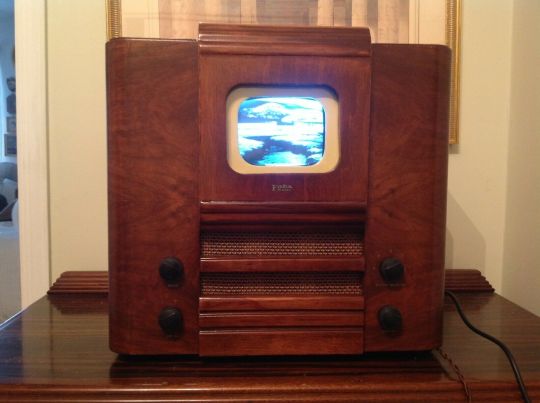
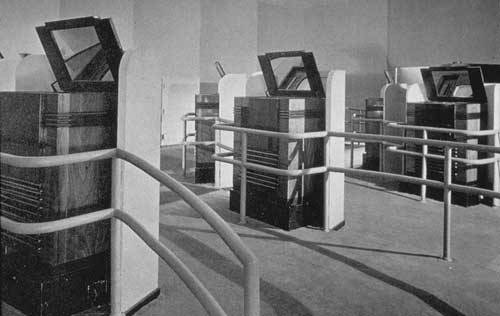
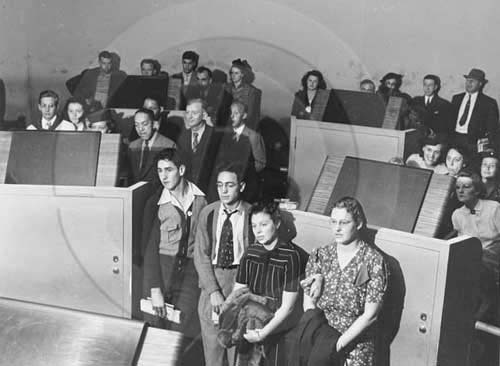
Pre-WWII Television Mid-1930s to 1945
In the last month, I’ve read no-less-then THREE separate fics referencing Steve and/or Bucky having more than a passing knowledge or experience of television pre-21st century — and I really wanted to clear that misinformation up.
Television, like most new technologies, existed for some time before being adopted by the wider public, and early models were prohibitively expensive for the everyday person. While yes, I think the boys would have seen a television demonstration at least once, they would not have owned one, nor would anyone they knew have owned one (except Howards, but when would they have seen it?).
First Commercial Televisions
The first ‘electro-mechanical’ televisions of the mid-to-late-1930s were grand, expensive affairs. The two of the main producers in the US were RCA with their TRK-12, TRK-9, TRK-5 and TT-5 models, and DuMont with their Model 180, and Model 181. These set would be handcrafted, with polished wooden cabinets modelled in the popular Art Deco “streamline” style of the times. Rather than an accessory, televisions of the 1930s and 1940s were large pieces of furniture and had little resemblance to today’s sets. Despite the large bodies, the screens themselves were only some 10-15″ wide diagonally.
These sets were sold in large, high-end New York department stores like Macy’s, Bloomingdale’s, and Wanamaker’s. They went for anything from $199.50 to $600 per unit, which when calculated for inflation, is about $3,500 to $11,000 in today’s money.
Around 7,000 sets were made in the US before WWII, and with such a massive price-tag, only around 2,000 sets were actually sold and in use across America. Most of the unsold units went into storage until after the end fo the war.
The first practical demonstration of television sets outside of those high-end department stores was the 1939-40 New York World’s Fair. There, visitors could visit the RCA Pavillion to see the “Hall of Television” with its thirteen TRK-12′s in action; as well as the “Radio Living Room of Tomorrow” and “Radio Living Room of Today,” which showed the technology at home in domestic settings. There were also live NBC broadcasts and opportunities for guests to be televised and see themselves on television — a unique novelty that came with an “I was televised” souvenir care to go with the experience. Other manufacturers at the World’s Fair also had their own television demonstrations, including General Electric, Westinghouse, General Motors, and Crosley.

So, what could those lucky 2,000 Americans watch? Well, televisions of this period could receive channels 1 through 5, and New York City had the only broadcast station. NBC began broadcasting regularly scheduled programming in 1939, along with CBS and Don Lee. Broadcasts ran for around 2-hours of content in the afternoon and 1-hour in the evenings. Programming during this time included all manner of content: sports, plays, operas, cartoons, cooking demonstrations, travelogues, fashions shows, skaters at Rockefeller Centre, and numerous live telecasts. The rest of the time viewers would only see the station’s test pattern.
WWII
All this slow progress came to a grinding halt when the US joined WWII. While some broadcasts continued, they were on a limited basis and included civil defence programming. All production of televisions was ceased, with engineers instead using their expertise for the production of radar and communications equipment for the military instead.
Post-WWII Growth
It wasn’t until after the end of WWII that television really got its explosion in popularity and became a household item for any aspiring middle-class family. At the end of the war, most people still didn’t know what a television even was, but only four years later, the majority had not only heard of them but wanted one. By 1949, the price of television sets had dropped and people were buying then at a rate of 100,000 a week! In addition to the drop in cost due to mass-production, families also benefited from suddenly having disposable income thanks to the post-war economic boom. By 1954 55.7% of households owned a television.
Steve, Bucky, and Pre-21st Century Television
So, realistically, how familiar would our boys have been with television before post-thaw/deprogramming? Well, going on my own favourite headcanon than the 1939-40 New York World’s Fair can be used as an almost direct analogue to the 1942 Stark Expo, I think there were two scenarios in which the boy would have even come across a television in the US:
Manhattan Department Store — Now I say Manhattan specifically, as despite Brooklyn having its own high-end department stores in Abraham & Straus and Frederick Loeser & Co., however, it doesn’t mean that they stocked televisions. My research seems to indicate that they were pretty exclusive products and only specific department stores stocked them — kind of the same way only certain car dealerships will sell you a Ferrari. Thus, I think if you were to go with the idea they say one in a department store display, you would have to assume they were inside one of the those gig-name Manhattan stores to even catch a glimpse. Seriously, they would not be catching a glace walking past a storefront, these would be deep inside for the distinguished partons.
Stark Expo — Again, assuming a degree of similarity between the real World’s Fair and the fictional Stark Expo, I think it’s fair to assume there would have been some sort of television demonstration. Now, whether the boys would have seen it is another thing. Bear in mind that these World Fair style attractions were MASSIVE, covering hundreds of acres of land, requiring internal transportation and remaining open for at least a year. Now, even if the Stark Expo was on a smaller scale, I doubt they saw even close to everything in just the evening they were there. So really I’d say its a 50/50 chance they saw a television there or not.
The only other place I think they would have possibly come in contact with television might be during the war, either:
While in Britain — Both Steve and Bucky would have (at least briefly) been in Britain during the war. Bucky, prior to deployment on the continent, and Steve with the Howlies during meetings with higher-ups. Television was actually more widely adopted in the UK, than in the US. Around 19,000 sets (compared to the US’s 7,000) were made in the UK, which assuming the rates of sale were similar would mean more than twice the number of sales. Broadcasting also started some years before those in the US. So, which all broadcasts were suspended the moment the war started, there is a chance that they would have come across a set sitting dormant somewhere or another.
Steve while on the USO tour in the home of a rich/famous donor — So one thing to consider is that Steve would have spent a while before Azzano hob-nobbing with the rich and famous as part of attempts to raid money for the war effort. And it’s not too outrageous to think that at least one of them would have owned a television and shown it off.
Other Points of Note
The first colour televisions did not come onto the scene until 1954.
There were, of course, no remote controls — not until 1950.
Image Sources
TRK-12 Promotional Photo, two women and one man | Source RCA TRK-12/120 (1939-40) | Source RCA TRK-9 (1939) | Source DuMont 180 (1939) | Source Working 1939 Art Deco Television Set | Source World’s Fair “Hall of Television” from the back w/o guests, 1939-40 | Source World’s Fair “Hall of Television” from the front w/ guests, 1939-40 | Source “I was Televised” Souvenir card (Front and Back), 1939-40 | Source
The full research document for this topic is available on the Discord’s “Patreon Clubhouse” channel ($3+ donors)

This post has been sponsored by my much loved and long-time Patreon supporter Joanna Daniels. She and I would like to dedicate the post to the loving memory of her mother Joan Daniels. She will be sorely missed.

[ Support SRNY through Patreon and Ko-Fi ] And join us on Discord for fun conversation! I also have an Etsy with upcycled nerdy crafts
#Steve Rogers#captain america#Television#History#history of technology#History of Television#Vintage Television#World War II Recipes#new york world's fair#WWII#WW2#New York#american history#historically accurate#Art Deco#fanfiction#fanfic#fanfic writing#Fanfic references#fanfic research#writing#writing resources#writing reference#fan fic writing#Captain America: The First Avenger#CAPTAIN AMERICA REFERENCE#captain america tfa#Bucky#Bucky Barnes#Brooklyn Boys
65 notes
·
View notes